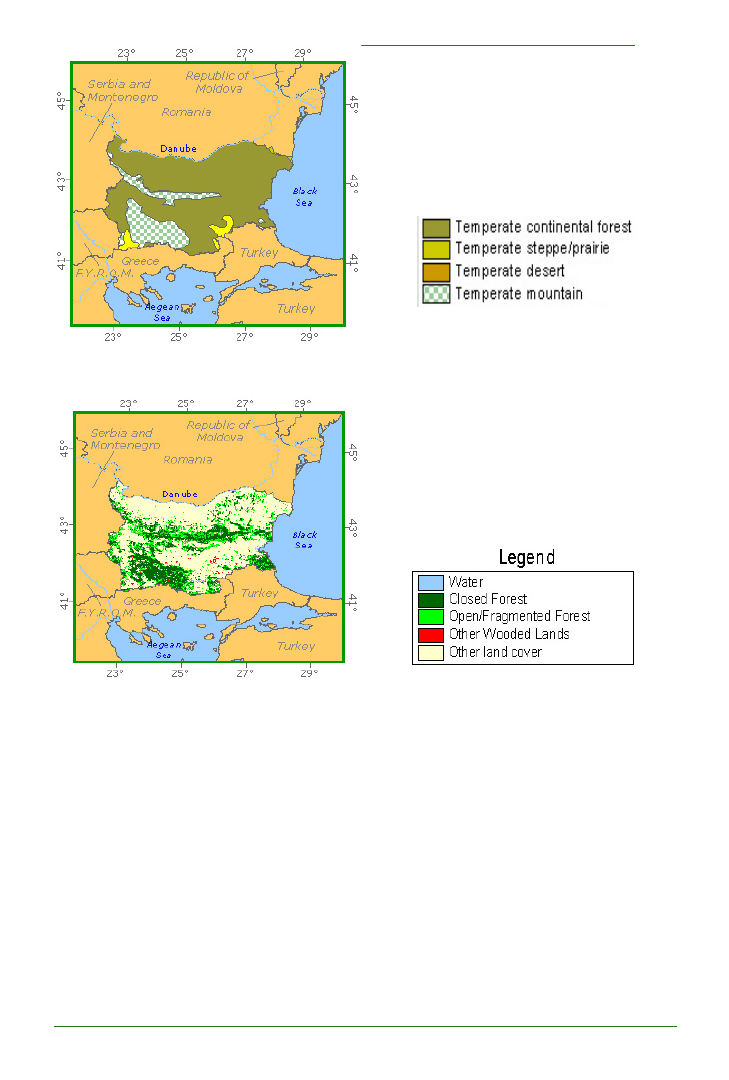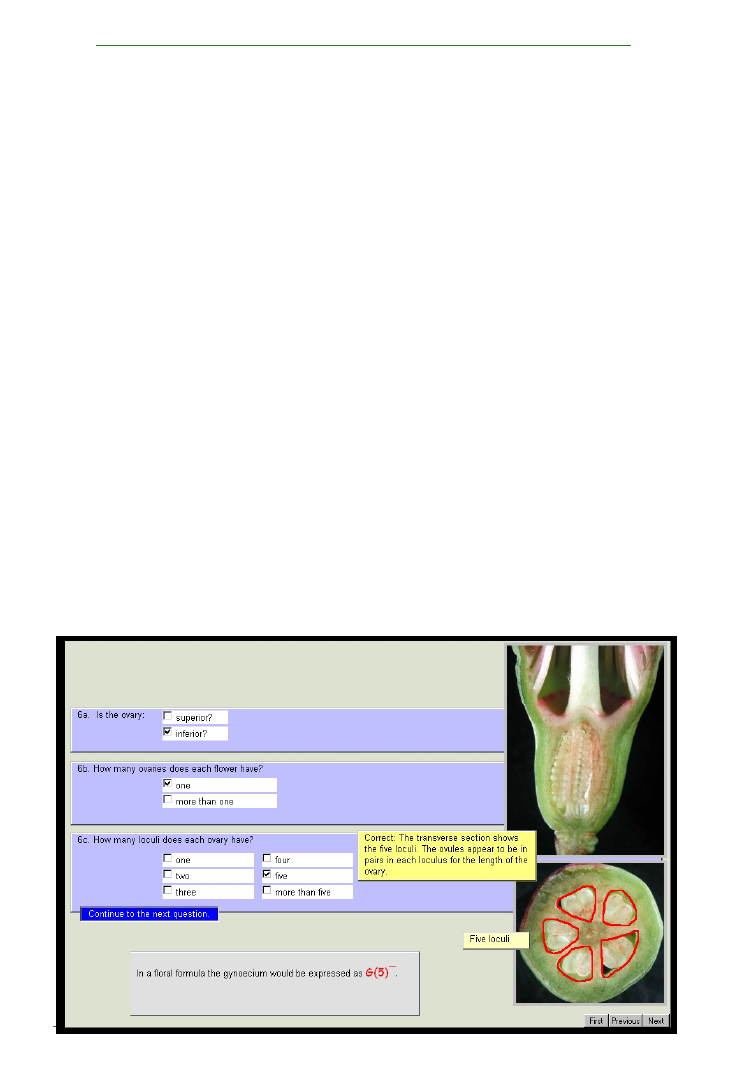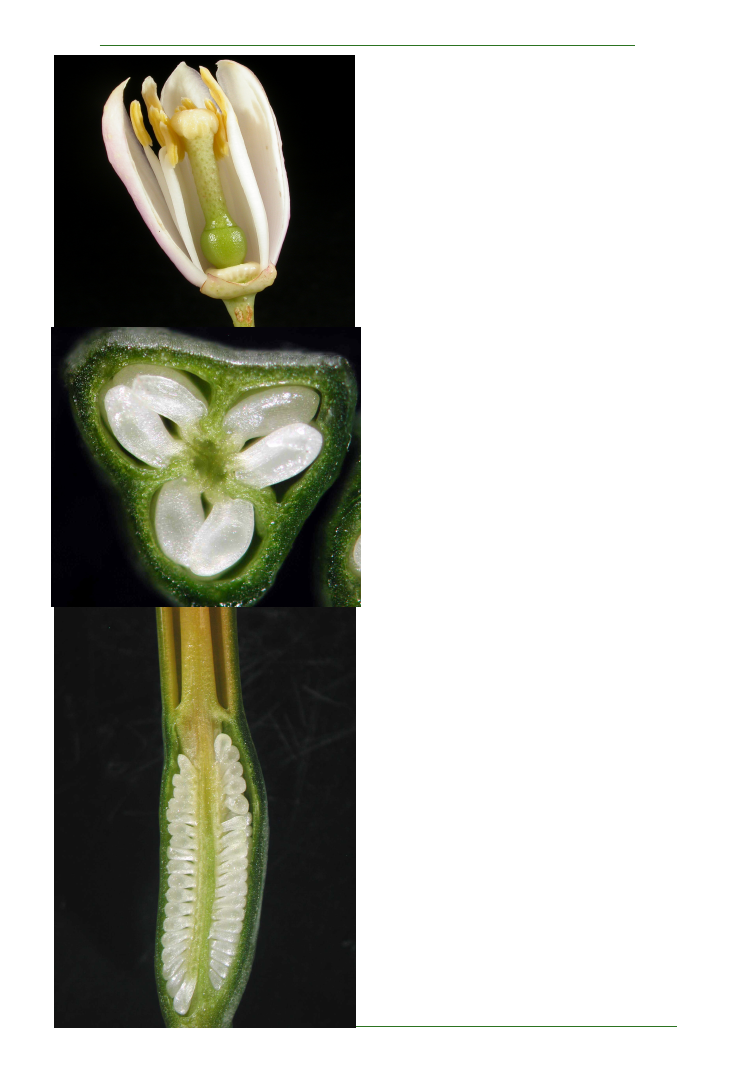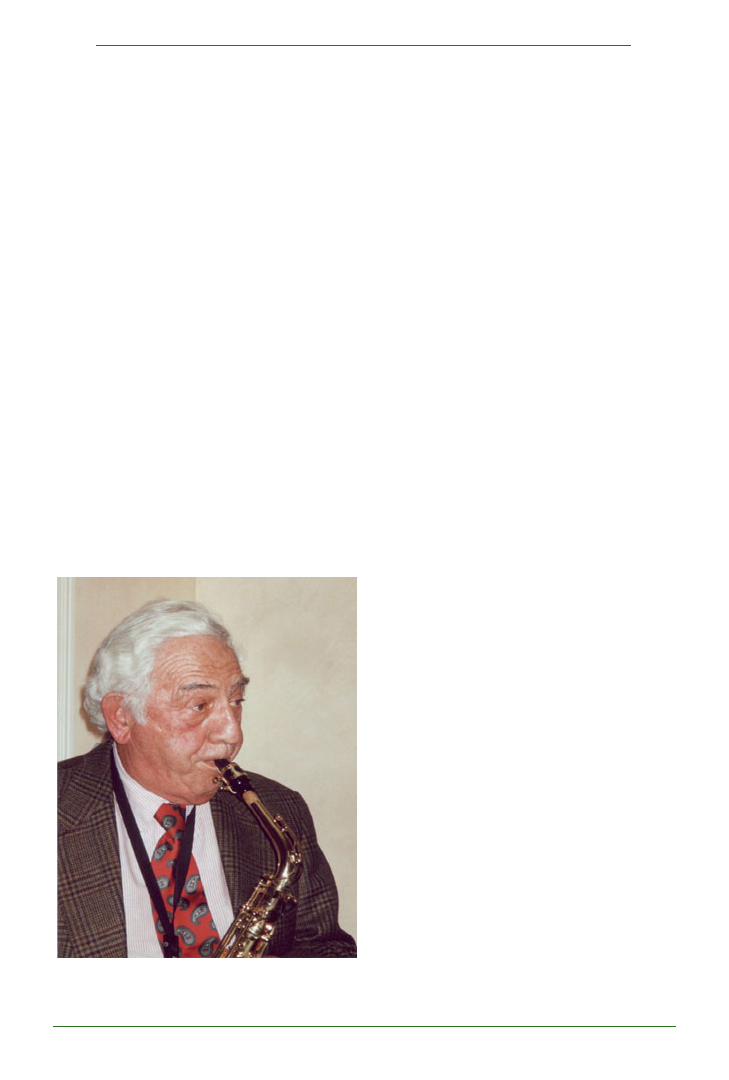
BULLETIN
FALL 2008
VOLUME 54
NUMBER 3
2@2
PLANT SCIENCE
ISSN 0032-0919
The Botanical Society of America: The Society for ALL Plant Biologists
THE BOTANICAL SOCIETY OF AMERICA
Leading Scientists
and
Educators
since 1893
Collecting for Education: Herbaria at Small Liberal Arts Colleges..................................................86
Botany in Bulgaria...........................................................................................................................91
News from the Annual Meeting
Botany 2008 Plenary Address. Solutions from Nature: How Mushrooms can Help
Save the World. Paul Stamets.........................................................................93
Regional Botany Special Lecture: Science Education for the 21st Century:Using
the Tools of Science to Teach Science. Carl Wieman......................................95
President’s Address, Karl Niklas.....................................................................................96
Awards.............................................................................................................................98
News from the Society
And The Survey Says: Taking the Pulse of BSA Members............................................99
BSA Education News and Notes...................................................................................102
Editors Choice: Gynoecial Structure Tutorial Web Site................................................104
Announcements
in memoriam
Arthur Galston, PhD. (1920-2008)...............................................................105
R.C. Jackson (1928-2009).............................................................................108
Charles Adam Schexnayder (1926-2008).......................................................109
Personalia
Dr. Brent Elliott Receives Greensfelder Medal from the Missouri
Botanical Garden............................................................................109
Dr. Peter H. Raven, Renowned Botanist and Environmentalist, Speaks at
World’s Largest GIS Gathering......................................................110
Symposia, Conferences, Meetings
African Journal of Plant Science....................................................................................110
55th Annual Systematics Symposium, Missouri Botanical Garden. “Climate Change
and Biodiversity in Africa and Madagascar.”................................................111
Positions Available
Department Chair,Department of Biological Sciences, Eastern IllinoisUniversity......111
Northwestern University Offers a Doctoral Program in Plant Biology and
Conservation..................................................................................................112
Award Opportunities
American Philosophical Society Research Programs.....................................................112
Harvard University Bullard Fellowships in Forest Research........................................113
Other
International Organization Formed to Address Problems in Cultivated Plant
Taxonomy......................................................................................................113
Brooklyn Botanical Garden Announces Supper Highlights: Reflections, Water
in the Garden.................................................................................................114
Chicago Botanic Garden to Break Ground on RIce Plant Conservation Science
Center............................................................................................................114
Revealing Double Lecture Reveals the Shroud of Turin................................................116
Books
Reviewed..............................................................................................................117
Books Received.............................................................................................................127
Student Chapters of the Botanical Society of America.................................................128

8 6
Plant Science Bulletin 54(3) 2008
P
LANT
S
CIENCE
B
ULLETIN
POSTMASTER: Send address changes to:
Botanical Society of America
Business Office
P.O. Box 299
St. Louis, MO 63166-0299
E-mail: bsa-manager@botany.org
Address Editorial Matters (only) to:
Marshall D. Sundberg, Editor
Dept. Biol. Sci., Emporia State Univ.
1200 Commercial St.
Emporia, KS 66801-5057
Phone 620-341-5605
E-mail: psb@botany.org
ISSN 0032-0919
Published quarterly by Botanical Society of America, Inc., 4475 Castleman Avenue, St. Louis,
MO 63166-0299. The yearly subscription rate of $15 is included in the membership dues of
the Botanical Society of America, Inc. Periodical postage paid at St. Louis, MO and additional
mailing office.
COLLECTING FOR EDUCATION:
HERBARIA AT SMALL LIBERAL
ARTS COLLEGES
Amy E. Boyd
Biology Department, Warren Wilson College
CPO 6074, Asheville, NC 28815-9000
telephone: 828-771-2018
aboyd@warren-wilson.edu
Natural history collections have served numerous
valuable functions for both biologists and society
for hundreds of years. Funk (2003) has outlined 72
different uses for herbaria, natural history
collections of plants preserved, labeled, and
systematically arranged for use in scientific study.
These uses range from verifying nomenclature
and providing material for DNA analysis to
documenting minor cycles in climate and providing
inspiration for painters. One of the most important
uses of natural history collections today is the
documentation and study of biological diversity
(Gotelli 2004, O’Connell et al. 2004, Schatz 2002).
In this time of severely declining biodiversity due to
human impacts on the environment, scientists are
pressed for time to determine the biodiversity that
exists in the world, as well as the geographic
distribution, geologic history, and ecology of that
diversity(Gotelli 2004). Natural history collections
like herbaria serve as repositories of all of these
types of information, as well as centers for research
on biodiversity (Ertter 2000, Krishtalka and
Humphrey 2000, Snow 2005, Suarez and Tsutsui
2004).
A second important function of natural history
collections has always been the training of new
taxonomists and natural historians. Today, with
the growing emphasis on molecular studies in
research and funding, we face a crisis in the decline
of taxonomists and natural historians. Just when
these specialists are needed most urgently to
study the declining biodiversity of our planet, we are
This year’s annual meeting, “Botany without
Borders,” provided us with an opportunity to visit with
Canadian colleagues on a campus with one of the
strongest botany programs on the continent. In this
issue we provide a summary of some of the major
addresses presented during the meeting as well as
other highlights and awards from our stay at the
University of British Columbia in Vancouver.
One of the symposia, “Botany on Public Lands”
addressed the needs of government agencies for
young botanists trained in basic botany, including
traditional plant taxonomy. In future issues we will
provide commentary concerning federal needs and
plant conservation. In this issue we feature a
perspective on the educational uses of small herbaria
at liberal arts colleges. Traditional plant taxonomy
is one of the areas in decline at many of our colleges
and universities, including some of our finest
research institutions. Perhaps this is a niche that
can be filled by master’s universities and small
liberal arts colleges such as Warren Wilson College,
the focus of our lead article.
To capitalize on the theme “Botany without Borders”
we thank the International Section of the Society for
providing the inaugural article in a series focusing
on botany abroad which will run for the next year. In
this issue we feature Botany in Bulgaria. Our intent
is to familiarize the membership with some of the
opportunities for botanical research and
collaboration in some of the less well-traveled
countries throughout the world.
We hope this issue will be a pleasant reminder of
a wonderful week for those of you who attended the
annual meeting - and an informative summary for
those of you who could not attend.
-the Editor

8 7
Plant Science Bulletin 54(3) 2008
Editorial Committee for Volume 54
Joanne M. Sharpe (2009)
Coastal Maine Botanical Gardens
P.O. Box 234
Boothbay, ME 04537
joannesharpe@email.com
Nina L. Baghai-Riding (2010)
Division of Biological and
Physical Sciences
Delta State University
Cleveland, MS 38677
nbaghai@deltastate.edu
P
LANT
S
CIENCE
B
ULLETIN
Samuel Hammer (2008)
College of General Studies
Boston University
Boston, MA 02215
cladonia@bu.edu
Jenny Archibald (2011)
Department of Ecology
and Evolutionary Biology
The University of Kansas
Lawrence, Kansas 66045
jkarch@ku.edu
Root Gorelick (2012)
Department of Biology
Carleton University
Ottawa, Ontario, Canada, K1H 5N1
Root_Gorelick@carleton.ca
failing to encourage students to go into studies of
organismal biology and failing to support the
institutions that can train them (Snow 2005,
Krishtalka and Humphrey 2000).
Despite their value in the face of declining biodiversity,
natural history collections today are struggling to
maintain support. Universities are closing the
doors of natural history museums and herbaria,
ostensibly to save money despite the fact that these
collections may be relatively inexpensive to maintain.
Research grant priorities tend to fall on the side of
molecular and medical research, leaving
organismal biologists and their institutions without
the funding to continue their important work (Dalton
2003, Gropp 2003, Suarez and Tsutsui 2004). Small
herbaria have received even less attention, and
while historically their importance has generally
been limited to the institutions in which they are
housed, the potential of connecting small herbaria
into a large-scale database and network may lead
to their value increasing and broadening in the near
future. SERNEC, a collaborative of herbaria in the
southeast, has recently received grant funding to
work on exactly this issue (www.sernec.org).
In this paper, I report on a qualitative study of 19
herbaria at small liberal arts colleges across the
U.S. My main objectives for this study were (1) to
determine in what ways these small college herbaria
are used, (2) to survey faculty who curate these
herbaria as to what their goals, wishes, and
missions are for these collections, and (3) to develop
a profile of the ideal herbarium for small liberal arts
colleges. After discussing the results of this survey,
I will end with recommendations as to what the
mission of an herbarium collection should be at a
small liberal arts college and what resources could
make these collections more accessible, useful, or
valuable.
Colleges were chosen for inclusion in the study
based on (1) the size and nature of the institution,
(2) whether they had an herbarium, and (3) whether
they had a faculty member who was willing to
participate. I sought to include as many colleges in
the study as possible. Out of the 33 schools I
attempted to include in the study, 14 did not
participate. Several schools chose not to participate
because their collections were quite small and the
faculty felt their information would not be useful to
me; others were contacted but did not respond to my
inquiry. The results presented below represent the
19 schools that chose to participate.
I visited five of the colleges included in the study and
interviewed their herbarium curators in person.
Faculty at the remaining 14 colleges were contacted
via email and responded to the survey either
electronically or in a phone interview, based on their
preference. The questions included in the survey
can be found at:
http://www.warren-wilson.edu/
~aboyd/herbquestions.htm.
The size of the student body at these various colleges
ranged from 750 to 3500 students, with a mean of
1664. The number of biology faculty at these colleges
ranged from 4 to 19, with a mean of 10. The
herbarium collections at these institutions varied
from approximately 500 to approximately 27,000
specimens, with a mean of 13,000. I believe that this
sample mean is high relative to the actual mean
size of herbaria at small liberal arts colleges; some
colleges did not respond to the survey because of
the small size of their collections, and other
collections may have escaped my detection because
of their small size. Therefore, the collections included
in this survey can be thought of as generally larger
and more active than the average small-college
herbarium. Interestingly, I found no relationship
between size of herbarium and size of student body
(r
2
= 0.014, F = 0.237, p = 0.632) or number of biology
faculty (r
2
= 0.000086, F = 0.0015, p = 0.97).
Universally, the herbaria are curated by biology
faculty, though the person in charge is not always a

8 8
Plant Science Bulletin 54(3) 2008
field botanist or taxonomist. In fact, one of the
herbaria is curated by an entomologist (Elzie
McCord, New College of Florida) at an institution
that currently does not have a botanist on the faculty.
Although the majority of the faculty associated with
these collections are botanists, only 53% reported
having specific herbarium training, and this ranged
from solely undergraduate training to Ph.D.-level
experience.
Based on anecdotal conversations with faculty, the
existence of an herbarium, as well as its size and
quality, at these small schools appears to be mostly
dependent on one (or, occasionally, several)
dedicated field botanist/taxonomist serving as
curator at some point in the collection’s history. The
establishment dates for the herbaria ranged from
the late 1800s through 1989. Many of the collections
were largely created by a single faculty member
who was particularly interested in floristic or
taxonomic studies; this person may or may not have
been the one who began the collection, but the bulk
of the collection was dependent on that person’s
enthusiasm, experience, and hard work.
The organizational system used in the herbaria
was split, with 50% using a taxonomic system and
50% arranged alphabetically by family. Those that
use a taxonomic organization were mostly based
on Cronquist (1968), though a few were based
upon the published flora for their region, and one
was organized according to the 1908 Gray’s Manual
of Botany (Robinson and Fernald 1908).
Only five of the 19 colleges included in the study had
computerized databases for their herbarium
collections, and these were not always complete.
Five more described the rudimentary beginnings of
a database or partial databasing (e.g., database for
only one taxonomic group of interest, or only for one
county). One reported a very old database that
would be difficult to access today. Only one had a
substantial part of the database online and
searchable. Several reported having data on 3x5
file cards or on computer punch cards. Eight
reported having no database at all.
USE OF THE HERBARIUM
The single most common use of these herbaria is
as a resource in teaching undergraduate courses.
Most of the faculty interviewed described using
specimens from the herbaria in their teaching, and
some said that other faculty in their department
would occasionally use specimens for teaching as
well. A few faculty used the herbarium in their own
research, but this was rare due to limited time for
research and/or the fact that their research interests
didn’t involve field collections. Several of the faculty
discussed, and some lamented, the trend of college
biology towards eliminating taxonomy and/or botany
from the curriculum. As mentioned above, one of
the schools did not have a botanist on the faculty,
and those that do have botanists most commonly
have plant ecologists or plant physiologists, not
plant taxonomists. Only three of the faculty interviewed
are actually plant taxonomists by training and/or
research emphasis. All three of these use their
herbaria extensively in their research.
Many of the faculty report that students use the
herbarium collection to confirm ID of plants; at
some institutions this is rare or periodic, while at
others it is quite common. At some of the herbaria,
students regularly or occasionally contribute to the
collection through research projects or collections
made for courses. Several of the faculty involve
students in their research on floristics or plant
ecology and the students learn to use the herbarium
in association with this research. One school (New
College of Florida) indicated that students with
special interest in organic gardening or medicinal
plants sometimes use the herbarium as a resource.
Use of the herbaria by off-campus parties is
common, though not frequent, and is quite varied.
Only 5 of the faculty interviewed indicated that there
was no use of the collection by individuals or groups
from off-campus. Most report some limited use:
visitors from local plant societies, requests for
loans or information from other scientists, reference
use by farmers/gardeners, visits by faculty from
other institutions or scientists from the state
Department of Natural Resources, Natural Heritage
Program, or Natural History Survey, U.S. Forest
Service, or local environmental organizations. These
uses by outside parties tend to occur once to
several times a year at most of these herbaria.
Several of the faculty interviewed indicated an interest
in increased community outreach.
For the most part, these herbaria do not receive
outside funding. Most of them do receive college
funds, though these can range from plentiful to
almost non-existent. Four of the herbaria have
received some outside funding, in the form of small
grants or scholarships, or from faculty contracts
with the U.S. Forest Service or state Department of
Natural Resources. Two of the schools have special
herbarium funds or endowments established by
alumni or emeritus faculty. Several receive work-
study funds for hiring student assistants as part of
their institutional funding.
When asked about who maintains the collections,
almost all interviewees reported that this work was
entirely or in part in their own hands. Nine have
students helping out, either as volunteers or as paid
work-study positions. Two have a staff member
who helps with caring for the collection in addition

8 9
Plant Science Bulletin 54(3) 2008
to many other duties, and four reported having
volunteers from off-campus who help in collection
maintenance.
GOALS AND WISHES
The two most common goals that the interviewees
cited for their collections were maintenance of the
collection, and having the collection serve as a
repository and record of the local flora. Coming in
a close second were updating nomenclature on
existing specimens, and creation of a searchable
database. Several indicated a desire to train students
and get them interested in the science of taxonomy,
and several were interested in creating a website
for the herbarium. Two interviewees indicated that
they had no goals or plans for the herbarium under
their care; they seemed to have little interest in the
collections and/or thought that they were of marginal
value. Some other goals mentioned included
training other faculty to use the herbarium, becoming
more visible with displays or tours, mounting a
backlog of specimens, digitizing label records or
creating an image collection, increasing the
collection through new specimens, or hosting
community events for outreach.
When asked what a “wish list” for their herbarium
would contain, i.e., what would make their herbarium
more useful, valuable, or accessible, the most
common responses involved more time as curator
to work on the collection and a complete, searchable
database. Some also asked for funding for an
assistant (student or staff). A number of respondents
listed things that could be done by a faculty member
with more time dedicated to the collection, such as
updating the nomenclature, creating an image
collection, confirming ID by students, and
reorganizing the collection. Others named improved
facilities, such as a dedicated room, fireproofing,
microscopes, and computers.
I asked each interviewee to describe what they
thought the mission of a small-college herbarium
should be. Universally the respondents indicated
education as the first priority, including both
education about plants and training of field and
curation skills. Beyond this, the most common
responses are research and local flora
documentation. Several also thought that a small
herbarium could and/or should serve as a
community resource. Individuals also cited
documenting campus arboretum specimens, K-
12 education, and raising consciousness in the
local community about plant conservation and
biodiversity.
Finally, interviewees were asked to describe
characteristics of an ideal herbarium for a small
liberal arts college. A couple of these interviewees
indicated that they didn’t think herbaria were very
important resources and should not be a high
priority for resources or time. However, these were
the minority, and most had clear ideas of what these
characteristics might be, including resources,
accessibility, and/or scope of the collection itself. In
terms of scope of the collection, all agreed that the
local flora should be the main focus for these small
herbaria, with limited specimens of plants from
other major biomes for teaching purposes. Other
high priorities were computers and staff/student
assistance. Regular maintenance and updating of
the collection and a searchable database were
commonly mentioned, and are tasks that could be
accomplished by the staff/student assistance cited
above. Faculty release time as well as faculty
recognition and summer compensation for work in
the herbarium were also a high priority, reflecting
the need for more time dedicated to these collections
as faculty have busy schedules. Facilities such as
cabinets, prep room, and microscopes were also
needed.
DISCUSSION
The primary use for herbaria at small liberal arts
colleges is, universally, undergraduate education
in botany. This matches the primary focus of the
institutions where these collections are housed:
small, liberal arts colleges are traditionally devoted
first and foremost to the mission of educating
students, and only secondarily, if at all, to the
acquisition of knowledge (Michalak & Friedrich
1981). These colleges also often advocate
experiential education, and herbaria can be great
tools for providing direct access to and experience
of the objects of study. They provide a context for
botany students not only to learn about the plants
themselves but to acquire skills in field study and
curation. We are in a time today in the biological
sciences when biodiversity is disappearing while
the taxonomic skills necessary to study that
biodiversity are also disappearing. Natural history
collections such as herbaria may be in danger of
disappearing as well at a time when they are most
needed to train the field biologists of our future.
Herbaria at small liberal arts colleges are faced
with the same trend in the biological sciences that
face large institutions: growth in microbiology,
molecular biology, and prehealth professions that
has led to shrinking funding and support for natural
history collections and research. In some ways,
this trend has hit smaller collections harder than the
larger ones. Plant taxonomy and even botany are
more likely to disappear completely from a small,
generalized department of biology, leaving
herbarium collections in the hands of botanists
without herbarium-related training, or even in some
cases in the hands of zoologists or microbiologists.

9 0
Plant Science Bulletin 54(3) 2008
Even when the collections have an enthusiastic
curator, that curator is likely to be severely limited in
time available. Professors at small colleges often
teach a heavy course load, leaving little time for any
research or other professional activities. When
these collections lack a curator with the time for and/
or interest in collection development and
maintenance, they may easily end up discarded,
deposited at larger institutions, or simply neglected,
left to the exploits of bugs, humidity, and time.
On the other hand, collections at small collections
also may be more likely to “fly under the radar,”
taking up little space or resources and therefore not
seen as a significant drain on the home institution.
Because of this, they may be maintained for many
years with little notice, continuing to be used for
teaching and occasional research or community
inquiry.
The most important resource for these herbaria—
the one that has made the difference between
minimal, neglected collections and those that are
well-developed and well-used—is an engaged
faculty curator. The main resource needed to make
these collections more valuable and useful,
therefore, is faculty time for maintenance,
organization, establishment of a searchable
database, training of student workers, checking/
updating identifications and classifications, and so
on.
Small herbarium collections tend to focus strongly
on their local flora and may serve as a valuable
repository for local floristic data. Searchable
databases, especially online, could make the
collections more accessible to researchers outside
the home institution, thereby increasing their
scientific value.
Based on my survey, the picture of an ideal herbarium
for a small liberal arts college emerges clearly and
is not an outlandish, unachievable goal. The
mission of such an herbarium would be focused on
undergraduate education, with student research
and taxonomic skills training as components. It
would have basic equipment and facilities (cabinets,
dedicated space, microscopes, computer) to allow
maintenance, development, and usability of the
collection. It would specialize on the local flora, with
some additional taxonomic and ecosystem breadth
as a resource for teaching. It would have an up-to-
date, searchable computer database, linked to the
internet to allow searching from off-site. The
collection would be curated by a faculty member
trained in herbarium curation skills and with an
interest in the collection (though this person need
not be a plant taxonomist, necessarily). The curator
would have institutional support for time dedicated
to the collection, be it release time from teaching,
summer support, an extra stipend or other
recognition. Lastly, the collection would be
accessible to the outer community as a resource for
study and research.
How far are existing collections from this vision? It
varies widely; some are very close to what I’ve
described, while others lack even the most basic
resources. I see three categories of collections that
were covered in my study, with different needs:
1) Collections that currently have no faculty member
interested in herbarium use or curation. There is
probably very little that would make a difference in
these collections until and unless a faculty member
emerges with an interest in the collection. Without
faculty support, there is very little hope that natural
history collections of any kind will be maintained at
these small colleges.
2) Collections that have been neglected or
underdeveloped but have an interested faculty
member overseeing them. The most useful
resource for these collections would be personnel
time, for the faculty curator and/or for student or staff
support. Personnel support would allow for repair,
updating, organization, new acquisitions, and
databasing, all of which would improve the value
and usefulness of these collections. Where needed,
funding for basic supplies and equipment (from
mounting paper to cabinets and microscopes),
either from the home institution or from small grants,
could also be an excellent investment into the
preservation and usefulness of these educational
collections.
3) Collections that are well-developed, well-
maintained, and have an active curator. The most
common criterion missing from these collections
is an online, searchable database. Support for
databasing these collections and making them
accessible via internet would make these
collections more useful both to their home
institutions and to scientists and other community
members outside the home institution.
Small-college herbaria have long been overlooked
and undervalued. The results of this study show
that there is considerable agreement about what is
needed to make these collections more accessible,
valuable or useful, and that the goals are, indeed,
achievable with a modest amount of support.
Acknowledgments: Many thanks to the participants
in the survey that has led to this article. Thanks also
to Donna Ford-Werntz at University of West Virginia
for her mentoring during my sabbatical research,
and to the Appalachian College Association and

9 1
Plant Science Bulletin 54(3) 2008
.
Warren Wilson College for their financial support of
the research.
Literature Cited
Cronquist, A. 1968. The evolution and classification
of flowering plants. Houghton Mifflin, Boston.
Dalton, R. 2003. Natural history collections in crisis
as funding is slashed. Nature 423: 575.
Ertter, B. 2000. Our undiscovered heritage: past
and future prospects for species-level botanical
inventory.
Funk, V. 2003. 100 uses for an herbarium (well at
least 72). American Society for Plant Taxonomists
Newsletter 17: 17-19.
Gotelli, N. J. 2004. A taxonomic wish-list for
community ecology. Philosophical Transactions of
the Royal Society of London B, 359: 585-597.
Gropp, R. E. 2003. Are university natural science
collections going extinct? BioScience 53(6):550.
Krishtalka, L. and P. S. Humphrey, 2000. Can
natural history museums capture the future?
BioScience 50(7): 611-617.
Michalak, S. J., and R. J. Friedrich, 1981. Research
productivity and teaching effectiveness at a small
liberal arts college. Journal of Higher Education
52(6): 578-597.
O’Connell, A. F. Jr., A. T. Gilbert, and J. S. Hatfield,
2004. Contribution of natural history collection data
to biodiversity assessment in national parks.
Conservation Biology 18(5): 1254-1261.
Robinson, B.L. and M.L. Fernald, 1908. Gray’s new
manual of botany, a handbook of the flowering
plants and ferns of the central and northeastern
United States and adjacent Canada. 7th ed. New
York: American Book.
Snow, N. 2005. Successfully curating smaller
herbaria and natural history collections in an
academic setting. BioScience 55(9): 771-779.
Schatz, G. E. 2002. Taxonomy and herbaria in
service of plant conservation: lessons from
Madagascar’s endemic families. Annals of the
Missouri Botanical Garden 89: 145-152.
Suarez, A. V. and N. D. Tsutsui, 2004. The value of
museum collections for research and society.
BioScience 54(1): 66-74.
Botany in Bulgaria
Anitra Thorhaug
Yale University
School of Forestry and Environmental Studies.
To most American botanists Bulgaria is the least
known and least traveled portion of the “new Europe”.
The Republic of Bulgaria ( 110 980 km
2
) is part of
the Balkan chain of mountains. Bulgaria is bounded
by Balkan nations of Macedonia and Serbia to the
West, Romania along its northern border which is
the Danube river, the Black Sea on the east coastline
, and Turkey and Greece beyond another set of
mountains on Bulgaria’s southern border. Thus, it
is simultaneously almost a Mediterranean country
(only a few hundred miles from the Mediterranean
sea, it receives weather patterns from the
Mediterranean), a Black Sea nation, and a Danubian
nation as well as having extensive Balkan
mountains. The southern and western portions are
forested ( Fig 1 and 2 ). The average elevation is
about 480 m. The Balkan Mountains cross the
country from the north-western corner to the Black
Sea and form the watershed between the Danube
River and the Aegean Sea. The northern side of the
Balkan Mountains slopes gradually to the Danube
River to form the northern Danubian Plateau.
Transitional plains lie to the south of the mountains
and are an important agricultural region. The
Rhodope Mountains, which form the boundary with
Greece on the south, rise to the country’s highest
point, Musala Peak, at 2 925 m. The mountains
contain a large number of ecosystems. The Black
Sea coastal areas range from marsh lands in the
north to wide beaches with a sloping shelf which
create a marine benthic habitat. (Note that extensive
pollution beyond the control of Bulgaria occurs both
in the Black Sea , where it is at the receiving end of
circulation from turkey, Georgia, Russia, Ukraine,
and Romania as well as down from the Danube
draining 9 nations into Bulgarian Danubian waters).
The principal river draining Bulgaria is the Danube.
Several other rivers, including the Iskur and the
Yantra, flow into the Danube. The Maritsa River
flows east to Greece and Turkey across the Thracian
Plain. Other important rivers are the Kamchiya,
which empties into the Black Sea, and the Struma
and Mesta, which flow south to the Aegean Sea.
Most of Bulgaria has a continental climate, with cold
winters and hot summers. The climate in general
is more severe than in other European areas of the
same latitudes, although a Mediterranean climate,
with dry summers and mild, humid winters, prevails
in the valley of the south-western Rhodope
Mountains. Climate can be defined as average
January temperatures range from 2° C near the
Black Sea to -17° C in central Bulgaria. July
temperatures range between 16° and 27° C. The
average rainfall is about 630 mm per year, ranging

9 2
Plant Science Bulletin 54(3) 2008
from a low of about 190 mm in the north-east, to a
high of about 1900 mm in the Rila Mountains. The
wettest period is early summer in most of the
country and autumn or winter in the southern valleys.
Snowfall is generally light except in the mountains.
Protected areas are generally forests or marshes.
They include about 10% of the land area in 753
protected reserves. There are 16 biosphere
reserves and 5 RAMSAR sites. The known number
of higher plants is said to be 3,572 ( FAO, 2008).
Forests cover 3,625,000 ha of which 267,000 are
primary, 2,028,000 ha are modified natural, 992,000
ha are semi-natural and 41,000 are plantations.
This is an increase since independence in 1989 (
FAO, 2005).
A large and rich region of agricultural productivity
lies in the valleys between the mountains and in the
delta of the Danube. This area has been in cultivation
for at least 9 thousand years ( Thracian and pre-
Thracian cultures). The many nations who have
dominated Bulgaria have prized exports from these
soils (Greek, Roman, Turkish, USSR) Presently
tobacco, fruits and vegetables are chiefly grown. A
high value export product is the attar of the Bulgar
rose (Rosa damascena and Rosa alba) grown in
valleys in central Bulgaria, which is not a native
variety, but was imported several centuries ago to
service the Western European perfume business.
I was fortunate to witness the late May rose
production with many miles of central Bulgaria in
full bloom. The forest products are largely exported
lumber with no value added. This is deeply troubling
since the limited forests are protected by various
reserves.
The outstanding institution with ongoing botanical
research is the Academy of Sciences of Institute of
Botany in the capital Sofia. Universities also do
some botanical research beyond their teaching
and most notably are the Universities of Sofia, of
Plovdiv, of Soumen, and of Stara Zagora. The
Institute of Botany at the Academy of Sciences
maintains field facilities in the Western Rhodope
Mountains, and near Dolni Lozen village . The fields
in which the Institute of Botany does research in the
following areas: Flora and florogensis,
Phytocoenology and Ecology, and Applied Botany
( medicinal plants, regeneration of rare and
endangered species, pollution effects on plants),
They also have extensive collections of plant fossils,
bryological and mycological, and vascular plants.
Note that fossil pollen is a paleo-specialty.
There have a series of botanical investigations at
the Institute of Botany since its inception in 1947
when it merged with the Royal Institute for Science
and Sofia Botanical Gardens. The staff is 100
persons with 47 Ph.D.’s. The Institute of Botany has
produced “The Flora of the Republic of Bulgaria” in
11 volumes, “The Fungi of Bulgaria” (1991-) in 4
volumes, “Synopsis of Flowering Plants of Bulgaria”
(1980) “Guide to Mosses in Bulgaria” ( 1992) ,
“Synopsis of Plant Communities in Bulgaria” ( 1995),
“Edible and Poisonous Mushrooms in Bulgaria” (
1998) , “Cenozoic Plants of Bulgaria” ( Eocene to
Pliocene) (2005), “Atlas of Bulgarian Endemic Plants”
( 2006) and various proceedings of botanical
conferences as well as other publications. The
journal Phytologia Balcanica (since 1975) deals
with taxonomy and biosystematics, chorology,
floristics, evolution, phytocoenology, paleobotany,
palynology, plant anatomy, embryology, ecology,
chemistry of medicinal and aromatic plants. The
mean number of annual publications is 52.
Obviously since Bulgaria is involved in the botanical
research of the European Union and NATO there
are cooperative programs with these nations for
mapping (as in Natura 2000) and in CORINE, in the
UNESCO_MAB programs, the EU Danubian and
Balkan Flora programs. Also there are FAO and
UNEP cooperative programs ongoing, as well as a
Black Sea Association of Institutes. The European
Initiative for Euro + Med Plant Base, Periodic Review
of Bulgarian Biosphere Reserves, National
Grassland Inventory Project, European native seed
Conservation Network, Conservation and
Sustainable use of Biodiversity in Strandzha
Mountain ( UNESCO_MAB), Transboundary
Cooperation Bulgaria-Greece (PHARE), European
Pollen Bank, Evolution of Climate in the Neogene
(NECLIME), Mapping of the Flora of Europe ( Finland)
are international cooperative projects undertaken
by the Institute of Botany.
This is the first in a series of national botanical
profiles conceived by the International Outreach
Committee of the Botanical society of America to
educate botanists about efforts internationally in
Botany.
.
The designations employed and the presentation
of material in this publication do not imply the
expression of any opinion whatsoever on the part of
the Food and Agriculture Organization of the United
Nations concerning the legal status of any country,
territory, city or area or of its authorities, or concerning
the delimitation of its frontiers or boundaries.
Map source: Global Forest Resources Assessment
2000, base map: ESRI

9 3
Plant Science Bulletin 54(3) 2008
Map 1 shows the ecological zones, as shown on
the FAO global map of ecological zones produced
as part of the FRA 2000. Please refer to FRA
Working Paper 20 for further information on the
Global Ecological Zone map.
Map 2 is an extract from the Global Forest Cover
map produced as part of FRA 2000. Please refer
to FRA Working Paper 19 for a background to the
production of the map.
News from the Annual Meeting
Botany 2008 Plenary Address
Solutions from Nature: How
Mushrooms Can Help Save the
World
Paul Stamets
Founder, “Fungi Perfecti”
“We are an evolutionary success – so far – but if
there was a U.N. of living organisms, would humans
be voted off the earth?” This question was raised by
Stamets at the beginning of his engaging and
stunningly illustrated address that opened the
scientific meetings in Vancouver. With humans
implicated as the instigators of the 6
th
major
extinction event, what can we do? GROW MORE
MUSHROOMS!
After a brief review of basic mycology, focusing on
the growth and ecology of the mycelium, “the true
foundation of the food web,” Stamets launched into
a four-part explanation of mycoremediation and
ended with medical and edible applications. Fungi
were the true colonizers of the land and dominated

9 4
Plant Science Bulletin 54(3) 2008
the landscape when Rhynia was getting its start.
Prototaxites, an upright form 30m tall, studded the
earth 420 mybp. Fossil remnants may be found in
Canada and Saudi Arabia. Stamets likens the
mycelium to an internet for nature – internet
architecture, with nodal optimization, mimics the
interwoven, branching mycelial structure. “As hikers
walk across these sensitive filaments, they leave
impressions, and mycelia sense and respond to
these movements.” And these mycelial mats can
be huge – thousands of acres in size.
Fungi play a variety of roles in nature and Stamets
suggested that we can take advantage of their
digestive powers by enlisting fungi to cooperate
with us in “mycorestoration” to clean up some of our
mess. He illustrated four specific applications:
mycoremediation, mycofiltration, mycopesticides,
and mycoforestry. In an experiment with the
Washington State DOT, a 10 yd
3
mound of diesel-
contaminated soil was inoculated with oyster
mushroom spawn and compared to two bacterial
treatments and a control. Within two months total
petroleum hydrocarbons were reduced from 20,000
ppm to less than 200 ppm, the mushrooms had
fruited and inaugurated a succession of other
mushrooms species and seed plants. There were
no visible changes in the control or either bacterial
treatment. On his own property, a small waterfront
farm on Puget Sound, he created a wood chip bed
inoculated with Stropharia rugoso annulata spawn
near the top of a ravine that emptied into the bay.
This bed filtered runoff from his farm animals and
was a back up to his septic system. Within a year
there was a hundred-fold drop in coliform bacteria
from his property. Trouble with ants or termites? Try
a mycopesticide! Since the 1980s and 90s
researchers have been working with
entomopathogenic molds, such as Metarhizium,
whose spores quickly penetrate the exoskeletons
of insects and kill them. Unfortunately, spores are
quickly removed from colonies by workers who
isolate and sacrifice themselves to protect the
queen. Like many fungi grown in culture, this
fungus produces concentric rings of vegetative,
presporulating mycelium and sporulating hyphae.
The insect colony will not tolerate spores, but the
presporulaitng mycelium is choice food - - and
natural bait. Two to three weeks after baiting colonies
of Formosan termites, eastern subterranean
termites, and fires ants, the colonies were
exterminated by the fungus. Mycoforestry includes
not just the obvious practice of inoculating the soil
with mycorrhizal fungi when replanting, but
facilitating decomposition and hastening forest
recovery by chipping and/or shading limbs and
debris left in the wake of harvesting or thinning the
forest.
Edible mushrooms, either store-bought or especially
wild collected, are a gastronomic delights and
Stamets has built his business, “Fungi Perfecti”
(http://www.fungi.com) on producing and selling
gourmet and medicinal mushroom growing kits
and medicinal mushroom products. He concluded
his presentation with examples of the antimicrobial
properties of the oyster mushroom, birch polypore,
and agarikon against E. coli 0157:H7 and
Staphylococcus aureus. Work also is being done
on the antiviral properties of various fungi.
Much of Stamets’ presentation is elaborated upon
in his recent book, Mycelium Running: How
Mushrooms Can Help Save the World. Paul
Stamets, 2005, Berlekey, California, Ten Speed
Press, from which the above illustration is taken.
- Marsh Sundberg
From
Mycelium Running
Paul Stamets, 2005
Ten Speed Press

9 5
Plant Science Bulletin 54(3) 2008
Regional Botany Special Lecture:
Science Education for the 21
st
Century: Using the tools of science
to teach science.
Carl Wieman
Carl Wieman Institute for Science
Education
University of British Columbia
Why Wieman? Who would be better to speak to a
society of professional scientists about the
importance of teaching science than the Nobel
Prize-winner in Physics who also was the Carnegie
Foundation’s U.S. University Professor of the Year
and chairs the National Academy of Sciences Board
on Science Education?
Why now? Wieman pointed out that while the
traditional role of science teaching was to train the
next generation of scientists, today the need is to 1),
prepare a more scientifically literate populace to
make science-WISE decisions, and 2), to prepare
a work force for the modern economy. Not only is our
target audience a different group of students, but it
is a much larger one.
What must we do? Our goal must be to transform
how students think so that they can think about
science, and use science, like a scientist (but not as
a scientist). Furthermore, this goal must be the
focus of individual instructors in their courses AND
in the curriculum as a whole. To be effective in this
endeavor we must: 1) be guided by fundamental
research principles; 2) devise practices based on
good data and standards of evidence; 3)
disseminate the results of our work in a scholarly
manner and incorporate what works for others; and
4) fully utilize modern technology.
After this brief introduction, Wieman proceeded with
a personal testimony about how he used to teach
(and most of us still do) and what happened to
cause him to change. This grew from his frustration
with graduate students who invariably came to his
lab with 17- years of “successful” education behind
them and yet were “clueless” about physics! Never-
the-less, 2-4 years later they were “expert” physicists.
What was different about the way he taught his
undergraduates and the way he taught graduate
students? Inquiry and investigation! What he quickly
discovered is that during the past two decades
there have been major advances in our
understanding of effective classroom practice,
cognitive psychology, and brain research and that
these three areas all are interconnected and paint
a consistent picture of how students learn. Student-
active learning in the classroom is shown to be
much more effective in information transfer and
retention, developing conceptual understanding,
and changing naïve beliefs about science. Cognitive
psychology says that cognitive load (short term
memory) is reached very quickly – we can remember
and process only 4-7 items. Furthermore, novice
thinkers (our students) process information very
differently from expert thinkers (us - - in our
discipline). The findings of cognitive psychology
reinforce and explain the results from classroom
studies. Effective teaching involves facilitating
students’ construction of new information based on
what they already know. They must do the work, but
we must be motivating and engaging and then
follow up with monitoring and guiding their thinking.
The expert teacher is an expert tutor!
This is the point where technology, if used correctly,
can help. Interactive lectures, using “clickers” can
keep students engaged as can interactive
simulations. But this is not automatic. Used as an
attendance and simple testing device they have
little benefit and may even be resented. Effective
use involves asking challenging, conceptual
questions, involving student discussion and
responses, and follow-up discussion led by the
instructor with minimal but non-zero grade impact.
And the perfect classroom is not enough. Develop
homework with authentic problems and useful
feedback. Brain research says that the brain is just
like a muscle – development requires strenuous
extended use! See the CWSEI web site (see
www.cwsei.ubc.ca) for a variety of tutorials,
powerpoint presentations, and other tools to
promote more effective student learning.
- Marsh Sundberg

9 6
Plant Science Bulletin 54(3) 2008
President’s Address
Karl Niklas
The bylaws of the Botanical Society of America
require that the President–Elect deliver “to the
membership assembled at the annual banquet a
botanically-oriented address”. Recently, it has
become something of a tradition to publish the text
of this address in the Plant Science Bulletin. To
some degree the publication of my address presents
something of a difficulty. The founders of the BSA
could not envision the effects of technology on how
we lecture to our students or how we speak with our
colleagues. Indeed, the 21
st
century has provided
us with a vast range of tools that extend our words
and concepts well beyond the lecture podium of the
classroom or the banquet hall. Mindful of the
stipulation that I present a “botanically-oriented
address” but having a deserve to provide something
that might be both entertaining as well as informative,
I presented a 10 minute film entitled Botany Without
Borders that was prepared in collaboration with
Christopher Julian (director and narrator), Edward
Cobb (photographic research and acquisition), and
Doug Fahl (musical score). This film, which can be
downloaded free of charge from the BSA website at
botany.org, strives to attract students to the
study of plant life as well as educate the general
public about botany, botanists, and the roles played
by botanical societies. It is my hope that Botany
Without Borders might be useful in the classroom
or as a feature added to the websites of colleges,
plant biology departments, botanical societies, etc.
Because this film is intended to “sell” botany and
inform the public about the roles of all botanical
societies, my colleagues and I have also prepared
a narration-less version so that the text can be
translated into any language. For this purpose, the
English version of the narration is published here,
which also fulfills the stipulation of the BSA bylaws
and perpetuates the tradition of publishing the
President-Elect’s “address”. The lyrics of the song
Photosynthesis (sung by the Hot Toddies) are also
provided at the end of the narration. Some may find
the words amusing; others may find them
informative.
Text of Film:
“Astronomers tell us we are made of stardust
because the elements manufactured in the hearts
of stars billions of years ago now reside in all life
forms. If this is true, then it is also fair to say that we
are made of starlight –– because all of Earth’s great
ecosystems and their food-webs ultimately rest on
the foundation of photosynthesis (the ability of plants
to harness the energy of sunlight and convert it into
their own living substance). People may call this a
blue planet, but it’s really a “green world”
The greening of our planet started billions of years
ago when animal-like and photosynthetic bacteria
entered into a symbiotic partnership that in turn
gave rise to fungi, animals, and plants. This pivotal
biological event changed our planet and the course
of evolution in many ways –– not the least of which
was to produce our oxygen-rich atmosphere and
the formation of the ozone layer. Today, plants
continue to make the air breathable, but they also
serve us in so many other important ways by
providing food, fiber, pharmaceuticals, and timber.
They also add beauty to our lives
In light of their great importance, it is surprising that
so many people know so little about plants. Indeed,
some people don’t even think of them as being
alive. Most plants move so slowly, we don’t even
notice their intricate activities with the human eye.
That we live in an animal oriented world is not
surprising. We are, after all, animals and it is fair to
say that our household pets give us far more loving
attention that our prized roses or orchids. Plants are
rarely cute or cuddly. But it is equally fair to say that
without plants, most of the world around us would
not exist.
So, what are “plants”? What are these creatures
that survive without benefit of blood, brains, or
muscles, summon without self-awareness, and
feed the world without intention? They are among
the oldest organisms that ever existed, some
achieving over 5000 years of age. They comprise
some of the smallest cells floating in our oceans
and some of the largest organisms that ever lived
on land or in the sea. Some swim with the aid of
flagella; others fly like helicopters or with the aid of
parachutes; but most are sedentary. Some are
colorless and parasitic. But most are green and
photosynthetic. Some live in trees, while others live
submerged in deep water. Their diversity in form,
size, and lifestyle is truly beyond description.
Perhaps this is why plants are often depicted in our
popular culture as “strange”, potentially dangerous,
if not malignant life-forms, or as comical “creatures”
from another planet. Yet, even when depicted in
these distorted ways, they remain fascinating
organisms that should demand our attention and
admiration. Indeed, they have inspired our art as
well as our science.
Who studies plants? The study of plant life is as
historically ancient as is harvesting and farming.
The earliest peoples who incorporated plants as an
important component in their diets were botanists
in the truest sense of the word. Their survival
depended on recognizing and observing plants
could be eaten and which were poisonous.
The first botanical writings known to us are from
Aristotle. Sadly, his botanical works are lost forever.
We only know of their existence because they are

9 7
Plant Science Bulletin 54(3) 2008
mentioned by some of his contemporaries, such as
his pupil, Theophrastus.
Theophrastus’s interest was in the classification of
medicinal plants. In many respects he was one of
world’s first great homeopathic physicians. This
focus dominated much of botany for many centuries.
But it was not until the time of the Swedish professor
and physician, Carl Linnaeus, that a formal
classification system was invented. It is still used
today for naming species of every form of life,
including bacteria, fungi, plants, and animals.
The discovery and cataloging of plants might appear
to be a dry subject. But the history of plant exploration
is rather romantic and, in some cases, full of tales
of danger and daring. Many early explorers, like
Alexander von Humboldt and J. D. Hooker, traveled
the globe collecting plants and secretively making
maps for military or commercial purposes. Indeed,
the exploits of the great plant collector Ernest Henry
Wilson traveling in China and Tibet earned him the
nickname “China Wilson” –– which some claim
was one of the role models for “Indiana Jones”.
Today, many botanists continue in the tradition of
these early explorers, collecting plants at their own
peril. Others study plants in the peaceful setting of
the laboratory or test garden, using chemistry,
physics, math, or computers. Indeed, the ways in
which plants are studied are almost as diverse as
plants are themselves.
Why study plants? Who should care? For botanists,
this is an important question. Well over 90% of the
living visible world is made up of plant life. We eat
them, we use them to build homes, we wear them
as textiles, we extract life-saving medicinals, and
communicate with the written page composed of
plant fibers. What often goes unnoticed is that
industry is fueled by plants in the form of their fossil
remains –– coal --–– the organic remains of ancient
plant life. In today’s hectic and complicated world,
plants remain as important as ever in the making of
bio-fuels, the mitigation of Global Warming by
binding carbon in their cell walls, and the production
of genetically modified plants to feed the world more
efficiently and economically. For those of us who
are professional botanists, it’s difficult to answer
the question “why study plants?” not because we
don’t know the answer, but because we cannot
imagine why anyone would not want to!
The study of plant life is a global enterprise involving
scientists from every nation. This endeavor occurs
in universities, botanical gardens, industrial
laboratories, and in natural preserves everywhere.
The role of botanical societies around the world is
to allow scientists to share their discoveries with
colleagues, students, and the general public in the
form of conferences, symposia, and publications.
These societies represent communities of botanists
–– academics of every age and ethnicity –– that
share a passion for the study of plant life.
The mission of these societies has a common
theme, articulated in many languages. It is to
“promote the study and inquiry into the form, function,
development, diversity, reproduction, evolution, and
uses of plants and their interactions within the
biosphere, and preserve plant life for future
generations to enjoy and use wisely.”
Regardless of where you live, joining a botanical
society and becoming part of the world-wide
community of plant biologists requires little effort.
Information about most botanical societies is
generally available on the internet. It is also provided
in many libraries that subscribe to botanical journals.
Many societies have membership dues at reduced
rates for students or non-professional botanists.
You do not need to be a “botanist” to join a botanical
society. You just need to love plants and to have a
desire to learn more about them. Members of these
societies include elementary and high school
students and teachers, gardeners, and farmers.
The field of botany has a rich history, a dynamic
present, and a fascinating future. So, come and join
us in this great enterprise and learn more about our
blue planet and green world.”
Lyrics to “Photosynthesis” from the video.
Come on little plants, we’re groovin’ in the sunlight
Spread your leaves and dance, reach up for the blue
sky
Soak up all the water, I won’t leave your roots dry
Drink it up now, baby, let your cells multiply, multiply,
multiply…
Photo, photosynthesis
Photo, photosynthesis
Photo, photosynthesis
Photo, photosynthesis
Photosynthesis is my favorite chemical reaction
When the plants are growing it gives me so much
satisfaction
Chlorophyll’s the green stuff, I just can’t get enough
Building up your cell walls, so you grow up big and
tall, big and
tall, big and tall…
Photo, photosynthesis
Photo, photosynthesis
Photo, photosynthesis
Photo, photosynthesis
note: the video, shown after the banquet, is available
on the BSA web site.

9 8
Plant Science Bulletin 54(3) 2008
Charles E. Bessey Teaching Award
Dr. Beverly Brown, Associate Professor of Biology,
Nazareth College, Rochester, New York, and
Immediate Past Chair of the Teaching Section of
the Botanical Society of America.
Dr. Michael Pollan, Knight Professor, University of
California--Berkeley and Director of the Knight
Program for Science and Environmental
Journalism.
Phycological Section Student Travel Award
Kendra Bunner, Illinois State University, Normal, IL
- Advisor, Dr. Martha Cook - Botany 2008
presentation: “Description of Zoospore Structure
and Development in Entransia fimbriata
(Charophyceae).”
Pteridological Section Student Travel Awards
Jay Bolin, Old Dominion University, Norfolk, VA - Dr.
Lytton J. Musselman - Botany 2008 presentation:
“Unraveling the reticulate evolutionary history of
the Isoetes hyemalis complex.”
Emily Butler, University of Wisconsin, Madison, WI
- Advisor, Dr. Thomas J. Givnish - Botany 2008
presentation:
“In the Light of Evolution: A Proposal to Integrate
Phylogeny and Ecophysiology in New World
Dryopteris.”
Amber Churchill, Stonehill College, North Easton,
MA - Advisor, Dr. J. Edward Watkins - Botany 2008
presentation:
“A Site for Sori: Consequences of Fertile/Sterile
Leaf Dimorphism in Ferns.”
Michael Sundue, New York Botanical Garden, Bronx,
NY - Advisor, Dr. Robbin Moran - Botany 2008
presentation:
“Systematics of grammitid ferns: Lellingeria,
Melpomene, and Terpsichore.”
Southeastern Section Student Travel Award
Nicole Hughes, Wake Forest University, Winston-
Salem, NC - Advisor, Dr. William K. Smith - Botany
2008 presentation:
“Winter color change: The adaptive role of
anthocyanin pigments in leaves of broadleaf
evergreen species.”
Awards
2008 BSA Merit Award
Dr. Thomas Rost, University of California Davis
Dr. Thomas L. Rost is one of the world’s foremost
researchers on root development. His research
record spans four decades and includes more
than 80 published papers in highly regarded journals
and chapters in scholarly books. He has led his
students and post-doctoral researchers to a
modern and accurate understanding of the
development of this model root system. Specifically,
he and his colleagues have shown that the
architecture of the root apical meristem changes
as the meristem ages and that the pattern of root
apical meristem ontogeny is associated with
periclinal divisions and gives rise to a three-
dimensional arrangement of periclinal derivatives
arranged in a helix.
Tom Rost has done more than any other current
structural botanist to bring the plant root to our
attention as a dynamic developmental entity.
However, his research has not been limited to
roots. He has authored or co-authored impressive
articles regarding seed structure and
histochemistry, plant morphogenesis, and
agriculture, and especially the recent studies on
Pierce’s disease in grapevine. Further, Tom’s
contributions to botanical education via his teaching/
mentoring and his writings have been quite well
known and recognized. The Botanical Society of
America is proud to recognize Dr. Thomas L. Rost
with this highest award.
Dr. Warren Wagner, National Museum of Natural
History
The botanical community is indebted to Dr. Warren
L. Wagner for his major contributions: monography
of Oenothera, The Manual of the Flowering Plants
of Hawaii, studies on speciation and relationships
of Marquesan plants, and service at the National
Museum of Natural History (Smithsonian Institution)
are among those that will be most rememberedIn
1982, he undertook what was probably one of the
most difficult and most needed contribution in
floristic botany: a flora of Hawaii. The previous flora
(Hillebrand, 1888) was out of date, and subsequent
contributions featured varied species concepts
and were published in scattered places. The 1990
Manual (rev. 1999) was a major factor in permitting
botanists to explore the amazing insular evolutionary
phenomena that the Hawaiian flora contains.
Wagner’s work on islands continued with the
Marquesas, where cladistic studies and
contributions using DNA permitted an
understanding of the biogeographic nature of the
remote and neglected archipelago. Wagner is both
imaginative and practical, and has served as Chair
of Botany at the Smithsonian, managed funds for
IAPT and ASPT, and served in numerous capacities
for professional societies. Through his mentorship
of younger botanists, his identity in monographic,
floristic, and phylogenetic botany has been
multiplied significantly.

9 9
Plant Science Bulletin 54(3) 2008
Genetics Section Graduate Student Research
Awards
The 2008 recipients of the Genetics Section
Graduate Student Research Awards, each of which
provides $500 for research funds and an additional
$500 for attendance at a future BSA meeting, are:
Renate Wuersig, Purdue University (PhD student)
and
Sunni J. Taylor, Texas State University (MS Student)
Phytochemical Section Student Travel Award
Cary Pirone, Florida International University, FL -
Advisor, Dr. David Lee - Botany 2008 presentation:
“A Mammalian Pigment in the Plant Kingdom.”
And The Survey Says: Taking the
Pulse of BSA Members
In July 2008, following on the heels of a productive
meeting of BSA’s Strategic Planning Committee,
the Botanical Society of America released a
comprehensive survey of its membership. Since a
survey of the entire membership had not been
conducted in at least the past five years, the Strategic
Planning Committee recognized a distinct need to
gather as much feedback as possible from
members in order to better inform the decisions of
the Council and the Executive Committee as new
societal goals are set. Utilizing the web-based
SurveyMonkey tool, BSA staff crafted the
questionnaire with input from the American Society
of Association Executives (a national resource for
non-profits like ours), President Pam Soltis, as well
as the Strategic Planning Committee. Two thousand
seven hundred sixteen members received the
survey via an email link (undeliverable emails have
been excluded from this total). In addition, paper
surveys were mailed to 140 members. This is the
first in a series of surveys that are being analyzed by
staff and society leadership in an effort to provide
insights into new areas for growth, membership
engagement, and impact on the society’s mission.
In essence, this data gathering exercise is and will
become a continual part of the fabric of the BSA as
we strive to deliver the best value and opportunities
to our members. The results are highlighted below,
and they provide some fascinating insights into this
community of scholars, scientists, and educators
that will help shape the future of the Botanical
Society of America.
The respondents
Compared to other surveys of this type, where a 5
or 10% response rate is considered favorable, the
BSA membership survey received a resounding
20% response rate. The diversity of responses
also matches up with the current distribution among
membership categories. Professionals were well-
represented at 70%, Students at 16%, Emeritus
response at 9%, K-14 Educators at 2%, and Retired
members at 2%; Amateurs, Affiliates, and
Associates made up the remainder of the
respondents.
Overall highlights
The exciting news from the survey is that BSA
members rate their society experience and
satisfaction very positively. Of those who responded,
62% state that they are “highly satisfied” with their
BSA membership. Together with the 28% that
ranked their experience as “somewhat satisfied,”
this places 90% of respondents in the satisfied
category. Only 1.5% of respondents expressed
dissatisfaction with their BSA membership. Recent
research by the American Society of Association
Executives has shown that academics and
members of scientific societies are among the
strongest society supporters and also strong
promoters of their professional affiliations (Dalton
& Dignam, 2007). This finding seems to have been
replicated here with the BSA members. In fact, 97%
of respondents would recommend BSA
membership to a colleague or student. This is a key
finding, as one of the best ways to grow a society
such as ours is through word-of-mouth and
member-to-non-member campaigns.
Overall, the survey results reaffirm the direction of
the society that has been laid out in the draft strategic
plan crafted earlier this year (to view the Strategic
Plan, visit the following web link: (botany.org/
governance/papers/Strategic_Plan_DRAFT-
033008.pdf ). Members also spoke highly and rated
favorably the areas where the society has
traditionally excelled. For example, the annual
scientific conference and BSA publications like the
American Journal of Botany and Plant Science
Bulletin score very highly throughout the survey.
These membership benefits are not only long-time
staples, but according to members, they are the
building blocks to which new and exciting ideas and
strategies can and should be added.
Member Benefits – Publications
As previously mentioned, the publications of the
society are highly valued. The American Journal of
Botany (AJB) is the number one reason why potential
members choose to affiliate with the society. The
overwhelming majority of respondents read the
journal monthly, and almost 50% read AJB solely
online while 20% read only the print version. The
remainder of respondents said that they rely on a
combination of both formats. The journal’s Table of
News from the Society

100
Plant Science Bulletin 54(3) 2008
Contents (TOC) is prime real estate space as most
readers use the TOC to find articles in their main
areas of specialty or other articles that perk their
interest. Only 16% of respondents say that they read
the entire issue. When selecting where to submit
an article for publication, BSA members rate the
quality and reputation of the journal as the leading
factor in their decision-making, followed by speed
of publication and ease of submission/peer-review,
which ranked head-to-head as the second most
important factors. The journal is another area for
future growth as it can raise the profile of the society
internationally and reach a diverse base of plant
scientists. Respondents expressed deep passion
for the journal and topics they wish to see covered.
Open-ended feedback converged around the
inclusion of high impact review articles, article
summaries in the journal’s front matter, and
maintaining the diversity of the journal’s coverage.
Much discussion also revolved around publishing
articles on educational topics in botany, which are
highly desired by many members, but do not
necessarily find a proper home in the American
Journal of Botany.
As for this publication, the Plant Science Bulletin
(PSB), 50% of respondents read all or more than
half of each issue. The PSB is currently placing
articles for the next issue online before publication
in print format. However, the membership expressed
deep misgivings regarding abandoning the print
newsletter, as 34% stated that they would read the
PSB less often if it were only available online. This
feeling permeated all categories of membership,
including students, who are recognized as the
leaders in researching and utilizing online content.
Member Benefits- Career, Community and
Collaboration
Another overriding result of the survey, which was
fairly expected, is that there is a strong need to view
the needs of BSA’s membership through the lens
of career development. Students, Professionals,
Emeritus, K-14 Educators, and Amateurs all place
differing values on BSA offerings and benefits. Key
areas for growing the society appear to focus on the
creation of community as well as opportunities for
peer contact and networking. The concept of
“fostering community” includes reaching out as a
leader and catalyst to bring differing plant societies
together in collaborative efforts (96% state this is
important), as well as bridging the “America” gap to
resolve disconnects between domestic and
international members (as evidenced in many open-
ended responses). Indeed, it was a top priority for
many members to make the society more user- and
benefit-friendly to our international members so
that the BSA becomes truly THE home for ALL plant
scientists and enthusiasts around the world.
Member Benefits-Personal and Professional
Development
Only one third of our respondents expressed that
that they are involved in some way with BSA inner
workings. Overall, the key ways that our membership
volunteers for the society is through submission or
editing of articles in the American Journal of Botany
or Plant Science Bulletin, serving on BSA
committees, and mentoring in the PlantingScience
educational outreach program. Given the current
high level of regard and satisfaction with the society,
it is somewhat surprising how little the membership
gets involved in volunteering or contributing to the
BSA. Since it has been demonstrated that members
who are involved in a society are more likely to stay
loyal to and promote the organization (Dalton &
Dignam, 2007), membership involvement and
volunteer opportunities will be a key to membership
retention and satisfaction in the future.
It is important to note that while BSA members cite
networking and peer contact as a high motivator to
the join the society, it appears that BSA members
are overwhelmingly not aware of current offerings
that foster community and the creation of networks
(PlantingScience/educational outreach, committee
service, career/job board, volunteer opportunities,
Student’s Corner). Creating more opportunities for
the development of social and professional
networking will be a main target area for growth as
the society evolves. In open-ended questions,
members suggested ideas such as regional/
smaller specialized meetings, blogs, listservs, and
collaboration with other societies as future
possibilities that might meet their needs for
interaction.
Next Steps
This membership survey is just the beginning. It
provides the keys that let all of us know how BSA
members determine value. It also gives intriguing
insights into new strategies and exciting ideas for
bettering the society’s offerings and attracting more
colleagues and students to this botanical home. In
the future, you will see the society continue to gather
data, test these survey results further, and tease out
new information. As new ideas and strategies
evolve, they will be shared with you. As a result of
this survey, the Plant Science Bulletin will begin to
feature short articles on different benefits and BSA
offerings
Please feel free to contact President Karl Niklas
kjn2@cornell.edu, Executive Director Bill Dahl
wdahl@botany.org
, or Membership & Subscriptions
Director Heather Cacanindin
hcacanindin@botany.org
, with your feedback and
ideas for the future of the BSA.

101
Plant Science Bulletin 54(3) 2008
For those that thrive on data, here are some of the
highlights from the survey results. You can also visit
the following web site to view more detailed
aggregated data:
h t t p : / / w w w . s u r v e y m o n k e y . c o m /
sr.aspx?sm=Hrtxj_2biVh3DMpETMSQ6C_
2blG3uzJ4EpwHd5qggEjuvao_3d
Membership
Most BSA members belong to many scientific
societies. The largest crossover occurs with the
following groups:
American Society of Plant Taxonomists (42%)
Society for the Study of Evolution (22%)
Ecological Society of America (26%)
American Society of Plant Biologists (14%)
Other highly mentioned societies that were not
included in the selection options are: International
Association of Plant Taxonomists, International
Organization of Paleobotany, Linnean Society of
London, Geological Society of America, and the
American Society of Naturalists.
Top four reasons members originally joined the
BSA:
Receive access/subscription to the American
Journal of Botany (61%)
Peers/Community/Networking aspects (48%)
Publish in the American Journal of Botany (35%)
Attend the Annual Scientific Meeting (30%)
It should be noted that student members, as might
be expected, place a much higher value on social
aspects of membership, such as networking and
the annual meeting, than other membership
categories. In fact, for students, one of the main
drivers for joining BSA was a recommendation to
join from another student or professor.
BSA Members Express High Awareness for the
Following BSA Benefits:
Top notch, peer-reviewed journal
Annual scientific meeting
Encouragement for lifelong development
Place to publish primary research
BSA Offerings with Low Awareness:
Associate and Gift Memberships
Student’s Corner
PlantingScience Program
Job/Career Board
BSA Members Do Not Perceive They Are Receiving:
Personal Development/Volunteer Opportunities
A Voice in Public/Government Policy
Educational Outreach Opportunities
BSA Publications
Of top importance to Authors’ Decision-Making
Process on Where to Publish:
Quality and reputation of the journal (92%)
Speed of publication (51%)
Ease of manuscript submission and peer review
(50%)
Page charge and/or color figure policy (29%)
Online accessibility of articles (26%)
Ability to publish ahead of print (3.5%)
Methods Members Support to Fund the Journal (in
addition to paid subscriptions)
Capital campaign to increase endowment support
(68%)
Increased paid advertisements (67%)
Increased price for subscriptions (30%)
Author pays model (19%)
References
Dalton, James and Monica Dignam.2007. The
Decision To Join: How Individuals Determine Value
and Why They Choose To Belong. ASAE and the
Center for Association Leadership, Washington,
D.C.
Respectfully submitted by Heather Cacanindin,
Director of Membership and Subscriptions,
hcacanindin@botany.org

102
Plant Science Bulletin 54(3) 2008
BSA Science Education
News and Notes
BSA Science Education News and Notes is a
quarterly update about the BSA’s education
efforts and the broader education scene. We
invite you to submit news items or ideas for
future features. Contact: Claire Hemingway,
BSA Education Director, at
chemingway@botany.org
or Marshall Sundberg,
PSB Editor, at psb@botany.org.
A Bonanza of Summer Botany for
Secondary School Teachers
This summer the BSA held its first professional
development sessions for secondary school
teachers in conjunction with Co-PI Carol
Stuessy in the College of Education at Texas
A&M University. These complementary
programs bring plant biology into secondary
classrooms across the nation, while supporting
innovative approaches of investigative case-
based teaching and open-ended inquiry
learning.
myPlant IT Summer Institute for Teachers,
July 7-18, 2008.
The Plant IT Careers, Cases and Collaorations
summer program allows secondary teachers
and students to explore plant-related biology
problems and career connections. Co-PI Ethel
Stanley and Margaret Waterman introduced
teachers to investigative cases focusing on
pollen forensics and remote sensing. In the
second week, teachers tried out the cases they
had adopted/adapted with students attending
the partner summer career camp. Students
also visited laboratories and learned about
podcasting with “Dr. Biology” Charles Kazilek.
Read more: http://tlac.tamu.edu/articles/
plant_science_camp_teaches_students__teachers
and www.myPlantIT.org
High school teachers Deborah Chabi (from
Palatine, IL), Cynthia Castillo (from Brownsville,
TX) and Torrye Hooper (from Houston, TX, not
pictured) present their poster to fellow teachers.
Students interview forensic palynologist
Dr. Vaughn Bryant in the TAMU Palynology
Laboratory.

103
Plant Science Bulletin 54(3) 2008
BSA Contact Information
All inquiries for the BSA Business Office should be
directed to:
Executive Director: William Dahl and / or
Administrative Coordinator: Wanda Lovan
BSA Business Office
Botanical Society of America, Inc.
4475 Castleman Avenue
P.O. Box 299
St. Louis, MO 63166-0299
Voice: 314-577-9566
FAX: 314-577-9515
E-mail:
bsa-manager@botany.org
Office hours are 7:30 am to 4:30 pm Central Time
http://botany.org/
President: Karl Niklas
niklas@cornell.edu
All inquiries about the Botany 2009 meeting (and any other
future meeting) should be directed to:
Mrs. Johanne Stogran, Meetings Manager.
Email:
johanne@botany.org
or
meetings@botany.org
Voice: 614-292-3519 Fax: 614-247-6444
http://www.botanyconference.org/
PlantingScience Summer Institute for
Teachers, August 4-13, 2008.
The PlantingScience program has connected
scientists as online mentors to 2,500 students
since 2005. NSF funds now provide the
opportunity to prepare teachers for the mentored
open-ended plant inquiry experience during
summer institutes. Kicking off the first
professional development session was a team
of scientists (Beverly Brown and Marshall
Sundberg) who authored the plant inquiries and
teacher leaders (Toni Lafferty of CH Yoe High
School and Allison Landry of the Louisiana
School of Math, Science and the Arts) who have
implemented the plant inquiries in their
classrooms.
Beverly Brown (Nazareth College) and Marshall
Sundberg (Emporia State University) share a
laugh and the fun of investigating seed
germination, respiration, and photosynthesis
with 11 teachers from across the nation.
Lisa Thompson (from Macon, GA) and Naomi
Volain (from Springfield, MA) conduct
photosynthesis experiments on leaf disks from
samples collected at the TAMU Horticulture
greenhouse.

104
Plant Science Bulletin 54(3) 2008
Gynoecium Structure Tutorial Web
Site
Previously I had noted that my botany and plant
identification students could not confidently
determine if leaves were alternate/opposite/whorled
or if leaves were compound what level of division
they displayed (e.g. trifoliolate/pinnate/palmate/etc).
I devised a tutorial (
http://www.csu.edu.au/
herbarium/HRT202/intro/intro.htm
) based on
numerous scans of living material for each feature,
complimented with an interactive ToolBook-based
test. This web site has been well received by a wide
range of students and evaluations have shown it is
particularly useful for distance education students
and as a pre- and post-practical exercise for fulltime
students.
Possibly from a student’s perspective the most
problematic part of floral structure (and thus keying
plants out) is the gynoecium. Determining whether
the ovary is superior/inferior or whether the carpels
are free/fused or assessing the number of carpels
can cause considerable confusion. Part of the
problem, for both students and teachers, is that the
floral parts are often very small and for many months
of the year the number of samples available to show
the diversity of structure is limited. With the help of
Kylie Kent (web page design) and Scott Black
(ToolBook based tests) I have developed another
tutorial and test, this time on gynoecium structure.
See:
http://www.csu.edu.au/herbarium/HRT202/
Gynoecium/intro.htm
Obtaining images for the leaf morphology tutorial
was relatively simple as shoots and leaves could
be quickly collected and scanned. The gynoecium
tutorial required transverse and longitudinal
sections of flowers to be prepared and then
photographed using a dissecting microscope.
Approximately 50 species were used in constructing
the tutorial and another 12 species were used in the
test. The species are a mix of Australian natives and
crop, weed and garden species that have been
introduced into Australia.
I haven’t seen anything of direct equivalence on the
www but wouldn’t be surprised if there is. If this is
the case hopefully the additional examples will be
useful. We would welcome feedback on the tutorial
and tests – from factual faults, layout improvements,
the inability to run some or all of the tutorial or tests
on some computers, etc.
Geoff Burrows, Charles Sturt University,
gburrows@csu.edu.au
Editor’s Choice

105
Plant Science Bulletin 54(3) 2008
Arthur Galston, Ph.D. (1920-2008)
Arthur Galston passed away the second week of
June 2008 after a short illness serving as Professor
Emeritus from the Yale University Department of
Molecular, Cellular, and Developmental Biology in
his retirement. He served as President of the
Botanical Society of America (1968) wherein he and
Graeme Berlyn resurrected the Physiological
Section (from the large number of members who
had switched to the American Society of Plant
Physiologists from the BSA). Galston also served
as President of the ASPP. He was awarded a series
of academic honors, including Guggenheim,
Fulbright and Senior National Science Foundation
Fellowships, both Phi Beta Kappa and Sigma Xi
visiting lectureships, and two honorary degrees.
His research concerned plant photobiology,
hormones, protoplasts and polyamines. The
research contribution for which he is most noted is
his suggestion and first evidence of the role of
riboflavin (not carotene) as the photoreceptor for
phototropism first published in 1949 in the American
Journal of Botany 36: 773-780. 1949 (also PNAS 35:
10-17, 1949; Science 111: 619-624, l950). He
published more than 320 papers in refereed
journals, as well as more than 50 articles on public
affairs, several successful textbooks of plant
physiology and two edited anthologies of papers in
bioethics. (This suggestion has recently been
proven by others, notably the laboratories of Winslow
Briggs.)
He was a leading plant physiologist in the 1940s to
1970s in the Botanical Society of America and
American Society of Plant Physiologists, both of
which he belonged to throughout his life and
continued to contribute. In his lifetime he contributed
not only to Botany, but to International Relations,
especially in the Far East and to the field of Bioethics.
He was born in Brooklyn, NY in 1920. Galston
received his undergraduate degree from Cornell,
and Ph.D. in Botany from the University of Illinois in
1943, then spent a year at Yale and then became an
assistant then associate professor at the California
Institute of Technology. He returned to Yale in 1955
as an Associate Professor of Plant Physiology in the
former Department of Botany. He retired in 1990, at
the (then mandatory) retirement age of 70 and
subsequently began teaching and doing research
in Bioethics. His unhappiness with the government
use of Agent Orange as a bio-weapon in Vietnam
caused him great personal distress so that he
instituted at the BSA Business Meeting in 1967 a
coalition of botanists and eventually other scientists
who finally testified before the US Congress and
were important in ceasing the use of Agent Orange
on the battlefield. He made contact with the Chinese
In Memoriam:
Announcements

106
Plant Science Bulletin 54(3) 2008
during his travels to Vietnam and lived in China,
becoming friends with Chou En-Lai. This helped
pave the way for the BSA exchange delegation to
China in 1978 wherein we were asked frequently
about Professor Galston.
In his own words: “In 1936, at the age of sixteen, I
found myself enrolling as a freshman in the College
of Agriculture at Cornell University, where, importantly,
tuition was free for residents of New York state. I
came not to study botany, but to spend one year of
study required as a prelude to entry into the College
of Veterinary Medicine at the same institution, where
tuition was also free. Veterinary medicine was also
not my burning passion: Inspired by Paul de Kruif’s
“Microbe Hunters” and similar books, my true
aspiration had always been to become an M.D. But
the year was 1936, The Great Depression was on
the land, my father had been out of work for several
years, and there seemed not the slightest possibility
of my being able to enter the long and expensive
study required to become a physician. A friend
happened to tell me about the Agriculture and
Veterinary Schools at Cornell, where “the price was
right”. Since I was confident that I could use my
saxophone-playing skills to earn my living expenses,
after an arduous freshman year and a successful
application for admission to the Veterinary School,
I declined the offer of entry by then Dean William A.
Hagan, and remained in the College of Agriculture
to major in Botany.
“The reason for this unanticipated change in direction
was, simply, infatuation with Professor Loren C.
Petry, who taught the yearlong course in Elementary
Botany. Not only his remarkably skillful lectures, but
also his entire persona attracted me. I so admired
him that I wanted nothing more than to imitate his
life style, impractical though that might have been.
The attractiveness of the academic career, with its
opportunities in teaching and research, seemed to
me an ideal worth pursuing. So I stayed on in
Botany, but deviated from Petry in choosing to
concentrate on plant physiology rather than on his
specialty of paleobotany.
“Cornell was then a center of excellence in the plant
sciences. I took advantage of this excellence by
enrolling in every possible botany course, then
bootlegged as many College of Liberal Arts and
Sciences courses in chemistry, physics,
mathematics, and geology as were permitted to
students in the Agriculture school. I emerged with
a BS in Botany in 1940. In the depression year of
1940 I received only one offer of a Teaching
Assistantship to support my graduate study, which
I gratefully accepted. In the fall of 1940, I ventured
into the terra incognita of the American Midwest, to
begin my graduate study in the Department of
Botany at the University of Illinois in Champaign-
Urbana. After a year of looking around, I chose to
work with Harry Fuller, a plant physiologist who was
a brilliant lecturer and coauthor, with another young
faculty member, Oswald Tippo, of an outstanding
textbook in Botany. Fuller introduced me to the world
of plant hormones and photoperiodism that were
the subject of my 1943 PhD dissertation.
Unfortunately, because World War II had engulfed
the United States in December 1941, Fuller was not
able to give me much guidance, for when the
Japanese conquest of Malaysia made rubber
unavailable to the Allies, he was sent on an extended
mission to South America to locate remnant stands
of Hevea brasiliensis. He remained absent for
several years, and I thus muddled through my
research pretty much on my own, except for
occasional critiques by mail. Under a wartime
mandate, I had to finish my graduate work in three
years, working full time every summer. I felt short-
changed, because of the shortened period of study
and also deprivation of my advisor.
“I had expected induction into military service
immediately after the receipt of my degree, but
again, serendipity intervened to change the course
of my life. I had taken several courses in biochemistry,
including a lively literature seminar run by a young
faculty member, Herbert Carter. While every other
student reported on animal and microbial
biochemistry, I spoke on such topics as
photosynthesis (Ruben, Kamen, and Hassid), auxin
(Thiemann, Bonner) and “florigen” (Chailakhian).
Carter was delighted with my “atypical”
presentations. Convinced that I could be of greater
use to the country as a scientist than as a soldier,

107
Plant Science Bulletin 54(3) 2008
Carter arranged for me to join Bonner’s group at
Caltech, working on the Emergency Rubber Project,
which sought to convert the Mexican shrub, guayule
(Parthenium argentatum Gray), into an important
rubber-producing plant. This was an exciting and
ultimately successful project, whose potential
importance was short-circuited by the simultaneous
success of the synthetic rubber program. Finally
drafted, I joined the Navy as an enlisted man, and
after many vicissitudes, served as Natural
Resources officer in Naval Military Government on
Okinawa.
“By the time I was slated for discharge in the spring
of 1946, my wife and I had become parents, and
since all four grandparents lived in New York City,
I was urged to find a job in the east, despite an offer
of continued employment at Caltech. I spent the
academic year of 1946-7 as an Instructor at Yale. I
then spent nine happy and productive years in
Pasadena, first as Research Fellow, and ultimately
as tenured Associate Professor. I flourished in the
plant physiology group led by Went and Bonner, with
young colleagues like Sam Wildman and George
Laties, and frequent contact with outstanding
scientists like George Beadle, Linus Pauling, Max
Delbruck, and Richard Feynman. Yet early in 1955,
mainly for family reasons, I succumbed to an attractive
offer from Oswald Tippo, newly appointed Chairman
of Botany at Yale, to return to Yale as a full Professor.
This was an important fork in the road for me; before
the move, I was doing experiments mainly with my
own hands, but thereafter I was greatly involved in
planning, equipping, and staffing laboratories,
teaching courses, and overseeing the research of
numerous grad students and postdocs. This was
fulfilling work, but very different from Caltech! In
1961, working with Edgar J. Boell, I was instrumental
in fusing Botany with Zoology to form the Department
of Biology, and planned the first unified Biology
course taught by the new Department. In 1966-7, I
served as Director of the Division of Biological
Sciences and in 1985-8, was Chairman of Biology.
I opposed the dismemberment of Biology into MCDB
and EEB, but note with pleasure the recent
strengthening of organismal biology in EEB.
“Since retirement, I have been associated with the
Institution for Social & Policy Studies, and serve on
its Executive Committee for the Interdisciplinary
Bioethics Project. For 12 years, I taught College
Seminars in Bioethics, and for two years, have
taught a new introductory bioethics course in Yale
College, which in 2003-4, attracted more than 460
students, making it one of the largest courses in
Yale College.
“My major research contribution, made at Caltech,
was to provide the first evidence for flavin-based
photoreception. This heterodox idea, opposed by
many pundits who favored carotenoids, including
Thiemann, Went, Bünning, Skoog, and Nobelist
George Wald, led me into difficulties with granting
agencies, and I accordingly shifted my research to
other areas. Time has proved this to have been a
mistake; one need only note the outstanding recent
results in flavin photoreception achieved by Briggs
et al. with phototropins and by Cashmore et al. with
cryptochromes.
“Two other “decision points” affected my life greatly.
From 1956 to 1978, I had been a consultant to
DuPont, and at one point was tempted by an
opportunity to leave academia for industry. It was
mainly my love of teaching and contact with students
that deterred me. The second critical decision
developed out of our government’s use of Agent
Orange and other chemicals to defoliate and kill
vegetation during the war in Vietnam. This violated
my deepest feelings about the constructive role of
science, and moved me into active opposition to
official U.S. policy. Starting with the business meeting
in 1967, and working with like-minded colleagues
around the country, I began a time-consuming and
distracting campaign against this type of chemical
warfare (Galston, 2001). Our small group was
eventually successful in helping to change our
country’s policy, when President Nixon ordered the
end of the spraying at the end of 1970, almost five
years before the end of the war. Since we now know
that Agent Orange contained significant levels of
teratogenic dioxins, this was an important
accomplishment. It was followed by five visits to
Vietnam and six to China, including the honor, with
Ethan Signer of MIT, of being the first American
scientists invited to visit the People’s Republic of
China. In 1971, we met Chou En-lai, then Prime
Minister, as well as King Norodom Sihanouk of
Cambodia, who then resided in Shanghai. This
pre-Kissinger-Nixon visit to China, as well as my
family’s subsequent (1972) summer on an
agriculture commune (Galston, 1973) was page 1

108
Plant Science Bulletin 54(3) 2008
R. C. Jackson (1928-2008)
Raymond Carl Jackson, Horn professor emeritus
at Texas Tech University, died on April 7, 2008
following a long illness. He grew up in rural Indiana
and fell in love with nature as a boy. He and his other
love from Indiana, June, were married in 1947. After
three years of service in the U.S. Army Air Corps-U.S.
Air Force, Ray entered Indiana University in 1949
earning a BA in 1952. Upon completing his Master’s
degree at Indiana, he moved on to Purdue in 1953
where he earned a Ph.D. in 1955. His fondness for
the Asteraceae began at IU thanks to some
persuasion from his mentor and long-time colleague
and friend, Charles Heiser. Soon after graduation,
he packed up his wife, two-year-old son and
newborn daughter, and moved cross-country to
Albuquerque (UNM) where he accepted a faculty
position that included herbarium curator. Here he
continued working on Helianthus and other local
composites, most notably, Haplopappus. It was in
New Mexico that he encountered the unassuming
desert annual, Haplopappus gracilis and found it to
have n=2 chromosomes, the lowest number ever
reported for a plant. Realizing the potential goldmine
of this easy to culture, short life-cycled composite as
a model for chromosomal, genomic and genetic
linkage studies, Ray shifted his focus to cytogenetics
– a shift that coincided with a career move to the
University of Kansas in 1958. Here he flourished
professionally, becoming a leading figure in
cytogenetics and plant biosystematics. In 1969 he
was appointed Chair of the Botany Department at
KU and served in that role until 1971 when he
accepted the chairship of the Department of
Biological Sciences at Texas Tech University. In the
1980’s Ray became an authority on chromosome
pairing behavior in polyploids, proposing and testing
models based on random synapsis and non-
random distribution of chiasmata. He modified and
applied these models to diploids, triploids, and
tetraploids through octoploids. He also proposed
similar models for predicting meiotic behavior in
translocation heterozygotes. Ray published eighty-
some peer-reviewed articles throughout his
prosperous professional career including three in
Science. He was a member of several honor
societies including Sigma Xi, Phi Sigma, and Delta
Phi Alpha (a national German language honor
society); and an active member of many professional
societies serving in several capacities including
editor of the University of Kansas Science Bulletin
and of the Transactions of the Kansas Academy of
Science; associate editor of Evolution; chair and
founding member of the Genetics Section of BSA;
Ray collecting H. gracilis seed (photo by June
Jackson)
news in many newspapers, including the New York
Times.
“Agent Orange also seems to have turned on other
activist genes in my makeup, and since then I have
been drawn increasingly by an interest in the social
and ethical consequences of scientific research.
After my mandatory retirement from Biology in 1990,
I helped to organize a Bioethics Project at Yale, and
am now an active member of that group, teaching,
leading seminars, and helping to plan activities.
Life does play funny tricks with our career plans!”
LITERATURE CITED
Briggs WR, Huala E (1999) Blue-light
photoreceptors in higher plants. Annu Rev Cell Dev
Biol 15: 33-62
Briggs, WR, Jarillo JA, Wu YJ, Liu D (1999)
Cryptochromes: blue light receptors for plants and
animals. Science 284: 760-765
Galston AW (1973) Daily Life in People’s China.
Thomas Y. Crowell, New York
Galston AW (2001) Falling leaves and ethical
dilemmas: Agent Orange in Vietnam. In A.W. Galston,
E.G. Shurr, eds, New Dimensions in Bioethics.
Kluwer Academic Publishers, Dordrecht, The
Netherlands
-Anitra Thorhaug and Graeme Berlyn. School of
Forestry and Environmental Sciences, Yale
University.

109
Plant Science Bulletin 54(3) 2008
DR. BRENT ELLIOTT RECEIVES
GREENSFELDER MEDAL FROM
THE MISSOURI BOTANICAL
GARDEN
The Missouri Botanical Garden has awarded Dr.
Brent Elliott, librarian and archivist at the Royal
Horticultural Society Lindley Library in London, with
the 2008 Greensfelder Medal. Dr. Elliott was honored
at the dedication of the Doris Waters Harris
Lichtenstein Victorian District at the Garden on June
13.
Dr. Elliott is a renowned authority on Victorian
gardens who collaborated on the landscape design
and interpretation of the new Victorian District. The
unified and enhanced area comprises the historic
southeast corner of the Garden and includes the
Kresko Family Victorian Garden and Tower Grove
House, country home of Garden founder Henry
Shaw.
The Albert P. and Blanche Y. Greensfelder Medal
was established in 1980. It honors individuals who
have made significant contributions to landscape,
garden and park planning, and design for urban
improvement.
Personalia
Charles Adam Schexnayder (1926-
2008.)
Charles Adam Schexnayder, professor emeritus of
LSU and husband of Claire Brown Schexnayder,
passed away at 1 a.m. Wednesday, June 4, 2008,
at his home. He was born on April 18, 1926, at
Lauderdale Plantation in St. James Parish. He had
been ill for almost a year with pulmonary fibrosis.
He graduated from White Castle High School in
1943, joined the Naval Aviation Program and studied
to be a naval aviator in World War II. Following the
cessation of hostilities of the war, he enrolled at
LSU, where he obtained a bachelor’s degree in
vocational agriculture in 1948, a master’s degree in
botany in 1950 and a Ph.D. in plant pathology in
1953. Upon completion of his degree in plant
pathology, he worked for the U.S. Department of
Agriculture at the Houma Federal Field Station with
a specialty in sugar cane production. In 1958, he
was offered a position working with the South
Puerto Rico Sugar Corp. in La Romana, Dominican
Republic, where he worked as a plant pathologist
and plant breeder with sugar cane in the area of
agronomy research. After four years, he moved his
family back to the United States and joined LSU with
the Department of Plant Pathology and Botany. He
served on the LSU faculty in 1962 as professor and
chairman of botany for 12 years. He was appointed
director of International Programs through the LSU
Agriculture Center. Dr. Schexnayder accepted a
position in Jamaica in 1988, where he worked to
build an agriculture college in Port Antonio on the
Caribbean. The project was sponsored by LSU and
the Department of State for the benefit of Third World
countries. Much of his work with international
programs was performed in West African countries
as chief of party providing educational programs for
helping African natives to cultivate crops for their
livelihood. He retired as professor emeritus in 1991
due to developing problems with his health.
He is survived by his wife, Claire Brown Schexnayder;
daughter, Jacqueline Schexnayder MacMurdo
Schneider and husband Brian; son, Dr. Michael
Schexnayder and wife Charlene Curole
Schexnayder; and five grandchildren, Christopher
James MacMurdo, Ross Bailey MacMurdo, Laura
Elise Schexnayder, Charles Michael Schexnayder
and Matthew Steven Walker. Also survived by his
brothers, Jean Manfred Schexnayder and wife
Sandra, Harold Joseph Schexnayder and wife Mary
Janice, and Lawrence Schexnayder and wife Jill.
-Russell L. Chapman, Ph D., FLS, Executive Director,
Center for Marine Biodiversity and Conservation
0202, Scripps Institution of Oceanography,
University of California San Diego, 9500 Gilman
Drive, La Jolla, CA 92093.
founding member of the Mid-continent Section of
BSA; Chair of the Botanical Section of AAAS-SWARM
Div.; and President of AAAS-SWARM Div., to name
a few. Throughout his career he was recognized
with many honors and awards including the BSA
Merit Award, the BSA Centennial Award, the AAAS-
SWARM President’s Award, Outstanding Educator
of America (1974-75), and an annual award
established in his name for outstanding student
presentation in the Mid-continent section of the
BSA. But perhaps the ultimate honor was in 1996
when he was eponymized with the genus,
Rayjacksonia in the Asteraceae. The family
suggests memorials to the Department of Biological
Sciences, Texas Tech University. Type in “biology”
in the search window on the On-line Giving page
(
https://securejava.tosm.ttu.edu/onlineGiving/
l
anding.do
) to select an endowed fund.
-Don Hauber, Department of Biological Sciences,
Loyola University, New Orleans.

110
Plant Science Bulletin 54(3) 2008
African Journal of Plant Science
(AJPS)
The African Journal of Plant Science (AJPS) is
currently accepting manuscripts for publication.
AJPS publishes high-quality solicited and
unsolicited articles, in English, in all areas of plant
science research. All articles published in AJPS will
be peer-reviewed.
Our objective is to inform authors of the decision on
their manuscript within five weeks of submission.
Following acceptance, a paper will normally be
published in the next available issue.
One key request of researchers across the world is
open access to research publications. The African
Journal of Plant Science is fully committed to
providing free access to all articles as soon as they
are published. We ask you to support this initiative
by publishing your papers in this journal.
Please visit our website
www.academicjournals.org/AJPS
for the Instruction
for authors and other details. Prospective authors
should send their manuscript(s) to
ajps.acadjourn@gmail.com ,
ajps@academicjournals.org
AJPS is also seeking for qualified reviewers as
members of its editorialboard. Please contact me
if you are interested in serving as a reviewer.
Best regards,
Prof. Diaga Diouf, Acting Editor
African Journal of Plant Science
E-mail:
ajps.acadjourn@gmail.com
E-mail:
ajps@academicjournals.org
http://www.academicjournals.org/AJPS
Symposia, Conferences, Meetings
Dr. Peter H. Raven, Renowned
Botanist and Environmentalist,
Speaks at World’s Largest GIS
Gathering
The 2008 ESRI International User <
http://
www.esri.com/events/uc/index.html
> Conference
(ESRI UC) featured renowned botanist,
environmentalist, biodiversity expert, and president
of the Missouri Botanical Garden, Dr. Peter H.
Raven. Raven discussed the significance of
biodiversity and the environment for sustaining our
world.
“Dr. Raven has played a vital role in teaching others
about the importance of biodiversity and in
researching our planet’s ecosystems,” says Jack
Dangermond, president, ESRI. “He’s making a
difference in securing our environmental resources.
We’re honored to have him as our guest and we’re
excited about the opportunity our users will have to
hear from such a distinguished individual.”
The ESRI UC, the largest conference in the world
devoted to geographic <
http://www.gis.com/
whatisgis/index.html
> information system (GIS)
technology, was held August 4-8 at the San Diego
Convention Center in California. The conference
drew approximately 13,000 users from more than
120 countries who came together to learn,
collaborate, and discover the latest developments
in GIS technology. The conference theme this year
was GIS: Geography in Action.
Raven talked about the importance of biodiversity
and how it influences our daily lives. He discussed
the threats-including loss of habitat,
overconsumption, and climate change-that impact
biodiversity and the solutions available for us to
preserve and improve our planet’s sustainability.
As part of the presentation, GIS was used to analyze
ecosystems and the myriad of plant and animal life
that inhabit them. In addition, GIS was used to
model future impacts to these bionetworks.

111
Plant Science Bulletin 54(3) 2008
Department Chair, Department of
Biological Sciences, Eastern
Illinois University
Responsibilities:
Provide effective leadership and vision to advance
the department, college and university mission and
goals. Administer all instructional programs in
Biological Sciences. Work with faculty and staff to
develop curriculum, and coordinate appropriate
academic assessment activities. Make
recommendations regarding all personnel matters
including hiring and evaluation of faculty and staff.
Advance faculty/student mentoring and research
programs. Administer all departmental budgets.
Communicate with alumni and facilitate actions
which promote diversity.
Qualifications:
An earned PhD in Biological Sciences or related
field. The successful candidate will have a teaching,
research and service record commensurate for
tenure at the rank of full professor. Evidence of
instructional excellence, scholarly achievement,
administrative experience, and effective leadership
is essential, as are strong communication and
interpersonal skills.
Starting Date:
July 1, 2009
Closing Date:
Review of applications will begin October 3, 2008
and will continue until the position is filled.
Applications:
A complete application includes a letter of intent
addressing the applicant’s strengths relative to the
position, current curriculum vitae, three letters from
professional references which address the
candidate’s qualifications for a department chair
position, and official graduate transcripts. The
application letter, current curriculum vitae, and three
reference letters should be sent via e-mail as MS
Word or PDF attachments to Dr. Diane Hoadley,
Chair, Biological Sciences Chair Search Committee,
coscand@eiu.edu.
Official graduate transcripts should be mailed to Dr.
Diane Hoadley, Lumpkin College of Business and
Applied Sciences, Eastern Illinois University, 600
Lincoln Avenue, Charleston, IL 61920-3099.
Positions Available
55
th
Annual Systematics
Symposium Missouri Botanical
Garden
“
Climate Change and Biodiversity in
Africa and Madagascar”
17-18 October 2008 With support from the
National Science Foundation
REGISTRATION: SATURDAY, October 18 Alison
Cameron: Species distribution modeling of
Madagascar butterflies and primates under
climate change, and implications for protected
areas network designKerry H. Cook: The African
climateLee Hannah: Impacts of climate change
on South African ProteaceaeJaclyn Hall: Remote
sensing and area analysis in relation to East
African vegetation and conservationE.A. Kellogg:
C4 grass evolution in relation to past and future
climate changeSara Oldfield: Climate change and
the conservation role of botanical gardens
Jonathan Patz: Making the links to sustainability/
human dimensions of climate changeDavid
Western: Integrated biodiversity studies and
landscape-scale conservation in East Africa
SPACE LIMITS REGISTRATION TO 400; PLEASE
REGISTER EARLY
Registration must be accompanied by a $75.00
registration fee, which covers the cost of
refreshments at the Friday mixer and lunch and
dinner on Saturday. Information on local hotels and
motels will be available to registrants. There is no
guarantee of food being available if you register
after 9 October. For electronic payment, see future
updates on symposium webpage. No refunds will
be granted after 24 September.
I plan to attend the Systematics Symposium.
Enclosed is my $75.00 registration fee. Please
make checks payable to “Missouri Botanical Garden”
I enclose my registration fee of $75.00 _____ I
request vegetarian meals: _____ My name and
professional address:
________________________________________________
______________________________________________________________________________
Phone:___________________
Fax:_________________
e-mail address:_____________
Please indicate if you are a)a graduate student
_______ or b)an undergraduate student _______
Mail registration form to: Systematics Symposium
Missouri Botanical Garden P.O. Box 299 St. Louis,
MO 63166-0299
For further information, contact: P. Mick Richardson
Email: mick.richardson@mobot.org Tel: 314 577
5176 Fax: 314 577 0820

112
Plant Science Bulletin 54(3) 2008
American Philosophical Society
Research Programs
All information and forms for all of the Society’s
programs can be downloaded from our website,
http://www.amphilsoc.org
Click on the “Fellowships
and Research Grants”tab at the top of the homepage.
Information about All Programs
Purpose, scope
Awards are made for non-commercial research
only. The Society makes no grants for academic
study or classroom presentation, for travel to
conferences, for non-scholarly projects, for
assistance with translation, or for the preparation of
materials for use by students. The Society does not
pay overhead or indirect costs to any institution or
costs of publication.
Eligibility
Applicants may be residents of the United States or
American citizens resident abroad. Foreign
nationals whose research can only be carried out
in the United States are eligible. Grants are made
to individuals; institutions are not eligible to apply.
Requirements for each program vary.
Contact information
Questions concerning the FRANKLIN, LEWIS AND
CLARK, programs should be directed to Linda
Musumeci, Research Administrator, at
LMusumeci@amphilsoc.org
or 215-440-3429.
Franklin Research Grants
Scope
This program of small grants to scholars is intended
to support the cost of research leading to publication
in all areas of knowledge. The Franklin program is
particularly designed to help meet the cost of travel
to libraries and archives for research purposes; the
purchase of microfilm, photocopies or equivalent
research materials; the costs associated with
fieldwork; or laboratory research expenses.
Eligibility
Applicants are expected to have a doctorate or to
have published work of doctoral character and
quality. Pre-doctoral graduate students are not
eligible, but the Society is especially interested in
supporting the work of young scholars who have
recently received the doctorate.
Award: From $1,000 to $6,000.
Deadlines
October 1, December 1; notification in February and
April.
Lewis and Clark Fund for Exploration and Field
Research
Scope
The Lewis and Clark Fund encourages exploratory
field studies for the collection of specimens and
data and to provide the imaginative stimulus that
accompanies direct observation. Applications are
invited from disciplines with a large dependence on
field studies, such as archeology, anthropology,
biology, ecology, geography, geology, linguistics,
and paleontology, but grants will not be restricted to
these fields.
Eligibility
Grants will be available to doctoral students
who wish to participate in field studies for their
dissertations or for other purposes. Master’s
candidates, undergraduates, and postdoctoral
fellows are not eligible.
Award
Grants will depend on travel costs but will
ordinarily be in the range of several hundred
dollars to about $5,000.
Deadline
February 15; notification in May.
Award Opportunities
Northwestern University Offers a
Doctoral Program in Plant Biology
and
Conservation
The biological world is currently confronted with
more rapid changes than it has faced during the
course of human history. Addressing a growing
need for expertise in plant science and conservation,
and in
partnership with the Chicago Botanic Garden <
http:/
/www.chicago-botanic.org/
>, the doctoral program
in Plant Biology and Conservation will provide
students advanced training in plant ecology,
evolution, and biology and in applied plant
conservation theory and methods - allowing them
to help solve real environmental issues, and to
pursue careers in academia, governmental and
non-governmental agencies, and beyond. The
application deadline for Fall 2009 admission is /
December 31st, 2008./
For more information please visit our website:
h t t p : / / w w w . p l a n t b i o l o g y . n o r t h w e s t e r n . e d u /
index.html

113
Plant Science Bulletin 54(3) 2008
Other
International Organization
Launched to Address PROBLEMS
in Cultivated Plant Taxonomy
Plants have been in cultivation for millennia, but it is
becoming evermore difficult to maintain clarity and
understanding in the science of naming cultivated
plants. This has been exacerbated in recent decades
by the proliferation of not only cultivars, but trade
designations and other devices used to market
them. To provide necessary leadership in the field
of taxonomy and nomenclature of cultivated plants,
a new organization was launched during the 5th
International Symposium on the Taxonomy of
Cultivated Plants in Wageningen, The Netherlands
on October 18, 2007: the International Association
for Cultivated Plant Taxonomy (IACPT).
Although often underestimated, there is significant
value of knowing a plant’s precise name and
understanding its origin, development, description,
classification and performance potential. Stability
and harmonization in cultivated plant names can be
achieved only with clear and widely accessible
information. The IACPT seeks to make information
sharing the core of its mission, and will encourage
international cooperation among individuals and
institutions interested in this field and related
disciplines.
To achieve its goals, the association will sponsor
symposia, publish a journal dedicated to cultivated
plant taxonomy, develop databases and on-line
resources for improving stability in the
nomenclature of cultivated plants and become a
vehicle for discussion and provide advice on the
implementation of the International Code of
Nomenclature for Cultivated Plants (ICNCP).
Members include taxonomists, international cultivar
registration authorities, representatives of plant
breeders rights authorities, industry scientists and
specialists, public garden professionals and many
others. Memberships are now being solicited, and
as of April, 2008, there are 70 members from 13
different countries. Five individuals represent the
US and Canada on the IACPT council: John
Wiersema, Michael Dosmann (Vice-president for
the Americas) and Dennis Collins (Secretary) for
the US; Freek Vrugtman and Bernard Baum for
Canada. Additional information on joining can be
found at: www.iacpt.net. Although there is yet no
policy for institutional memberships, inquiries on
the subject are welcome and some mechanism
will address this in the future.
###
For more information, contact Dennis Collins at
617-607-1961 or e-mail at
dcollins@mountauburn.org
Harvard University
Bullard Fellowships in Forest
Research
Each year Harvard University awards a limited
number of Bullard Fellowships to individuals in
biological, social, physical and political sciences to
promote advanced study, research or integration of
subjects pertaining to forested ecosystems. The
fellowships, which include stipends up to $40,000,
are intended to provide individuals in mid-career
with an opportunity to utilize the resources and to
interact with personnel in any department within
Harvard University in order to develop their own
scientific and professional growth. In recent years
Bullard Fellows have been associated with the
Harvard Forest, Department of Organismic and
Evolutionary Biology and the J. F. Kennedy School
of Government and have worked in areas of ecology,
forest management, policy and conservation.
Fellowships are available for periods ranging from
six months to one year after September 1
st
Applications from international scientists, women
and minorities are encouraged. Fellowships are
not intended for graduate students or recent post-
doctoral candidates. Information and application
instructions are available on the Harvard Forest
web site (
http://harvardforest.fas.harvard.edu
).
Annual deadline for applications is February 1
st
.
“Perhaps the most striking point by which the
educational methods of the present are
distinguished from those formerly in vogue is the
great prominence which is given to inductive
methods, and as a consequence, the little attention
that is now paid to mere facts, as contrasted with the
great stress laid on the processes by which those
facts are acquired...and teachers seem almost
unanimous in believing that the training in methods
is the primary object of such work, and that the
informaiton involved, important though it is, must be
given a subordinate place.”
Biological Teaching in the Colleges of the United
States
John P. Campbell, 1891

114
Plant Science Bulletin 54(3) 2008
Brooklyn Botanic Garden
Announces Summer Highlights—
Reflections: Water in the Garden
Find cool relief from the sizzling summer heat at
Brooklyn Botanic Garden (BBG) with its Reflections:
Water in the Garden interpretive program highlights,
from July 12 through September 7, 2008. In the
glittering reflection of BBG’s exquisite aquatic
features, visitors can experience the many diverse
displays of water throughout the “gardens within the
Garden,” learn more about water and conservation,
and explore how plants use and live in and around
water. Reflections: Water in the Garden is BBG’s
first-ever program focusing on its exhilarating water
features and offers visitors an interactive self-guided
tour of the aquatic elements of BBG, free guided
strolls, special educational workshops for children
and adults, and more.
The sound of a trickling brook calms the nerves, the
glassy surface of a pond inspires contemplation,
and the playful jets of fountains elicit joy. Water itself
is an essential element, vital to all living things.
Reflections: Water in the Garden invites visitors to
revel in BBG’s distinctive landscape—including
fountains, water lily pools, a running brook, small
waterfalls, and an interactive water table for kids.
Interpretive panels at some of the most popular
water features and colorful informative signs about
flora living in or near them will introduce visitors to
the myriad ways plants interact with water.
Visitors can pick up a special Reflections brochure
and embark on a self-guided adventure or meet one
of BBG’s enthusiastic Garden Guides for a FREE
Reflections tour and receive a narrated introduction
to the featured water displays. On Tuesdays, FREE
Reflections tours begin at 11 a.m. and 1 p.m., as well
as 3 p.m. on weekends. The Reflections tour will
supplement the popular 1 p.m. free Seasonal
Highlights tour.
Reflections: Water in the Garden will highlight ten
areas within the Garden, each of which is anchored
by water. An interpretive placard nearby also includes
other interesting plants in the immediate area.
Compelling, on-site interpretive text helps visitors
learn about wetland plant species, submerged and
emergent ecosystems, and other water-related
topics. Highlighted water features in the Garden
include the elegant Rose Arc Pool, where the Call of
the Sea statue is enveloped by cattails (Typha
species) and celebrates the freedom and vitality of
open water. The Native Flora Garden’s bog, pond,
and ephemeral stream, which represent water
habitats native to this region that play a vital role in
sustaining plant and animal life in the Northeast.
Throughout the summer, visitors will experience
the colorful Discovery Carts with hands-on water-
related activities for the whole family. The Gardener’s
Resource Center will help visitors find answers to
frequently asked water questions and inspire them
with a collection of beautiful books on water
gardening, rain gardens, and water features in
breathtaking gardens around the world.
The Steinhardt Conservatory Gallery will present
Reflections in Collage: Works by Diane Miller, an
exhibit of striking collage work that echoes the
movement and textures of BBG’s water features.
Miller’s unique collages are inspired by the rocks,
trees, mists, clouds, and rain of the North Temperate
Zone, and offer a vision of unpolluted nature full of
dramatic movement and the textures of the earth.
In the Wonderful Water Plants! Discovery
Workshops (Sunday, July 13 and Sunday, August
10, 2–4 p.m.), children will experience the Garden’s
interactive water table and learn all about water
plants. On Special Reflections Saturdays (Saturday,
July 26 and Saturday, August 16, 2–4 p.m.), water-
related mini-workshops will include potting up a
water plant or making a pond postcard and can be
enjoyed by visitors of all ages.
A container water garden display will be featured
near the Terrace Café during the summer season,
adding to the sensual pleasure of dining in the
Garden. Home gardeners will be inspired to
incorporate water into their own garden designs.
And to help them get started, the Garden Shop and
Gift Shop will offer a special collection of interesting
plants, fountains, books, and other water-inspired
gifts.
Romi Ige, manager of interpretation at Brooklyn
Botanic Garden, says, “We are very excited to present
Reflections: Water in the Garden and to offer our
summer visitors an opportunity to cool off beside
the myriad water features of Brooklyn Botanic
Garden. Whether reveling in the lushness of the
Native Flora Garden, relaxing in the shady calm of
the brook and terminal pond, or gazing at the
stunning composition of the lily pools, visitors of all
ages will be able to learn about plants while
experiencing the multisensory pleasures of water.”
Ige adds, “Water has a unique capability to alter or
reflect a range of emotions given all of its many
permutations, from shooting sprays to placid pools
to gurgling brooks to splashing waterfalls—water
ignites the senses.”
In addition, there will be a special Reflections-
themed display in exhibition cases in the Rotunda.
It will feature herbarium specimens of aquatic
plants and illustrations of water-lilies and lotuses
from the Garden’s rare-book and Florilegium Society

115
Plant Science Bulletin 54(3) 2008
Chicago Botanic Garden to Break
Ground
on Rice Plant Conservation
Science Center
The Chicago Botanic Garden has announced that
it will break ground June 3 on the Daniel F. and Ada
L. Rice Plant Conservation Science Center, a facility
designed to serve as an international center for
plant conservation research and home to the
nation’s only doctoral program in plant biology and
conservation.
When completed in fall of 2009, the 36,000-square-
foot Daniel F. and Ada L. Rice Plant Conservation
Science Center will provide state-of-the-art
laboratories and teaching facilities for over 200 PhD
scientists, land managers, students, and research
staff, and will include teaching facilities required for
a unique doctoral program in plant biology and
conservation that the Chicago Botanic Garden will
conduct with Northwestern University.
While the Chicago Botanic Garden has conducted
a plant conservation research program for more
than ten years, the Rice Center will enable the
Garden to expand research capabilities into the
study of native plants for medicinal and economic
benefits, reproductive biology, seed biology and
population genetics, and soil research that could
lead to better understanding of the manner in which
native plant habitats can absorb carbon from the
atmosphere.
The building will feature a viewing gallery designed
to provide the Garden’s 760,000 visitors with an
opportunity to see Garden plant scientists at work.
It will also feature a 10,000 square-foot living green
roof, open to the public to demonstrate the best
plants for green roofs in the Midwest.
Designed by Booth Hansen, the Rice Center will
use materials and systems to earn a “gold” rating
for sustainable design from the U. S. Green Building
Council.
The groundbreaking ceremony will be preceded on
June 2 with an afternoon “Seeds for the Future”
ceremony involving students from three Chicago
Public Schools. Together with Garden scientists,
the students will contribute items to a “Seeds for the
Future” time capsule, which will be placed in the
Rice Center to be opened in 50 years.
Why Save Plants?
According to the World Conservation Union, 30
percent of the world’s plants are threatened with
extinction by 2050. Since plants provide all the
necessities of life, food, shelter, clothing, medicine
and oxygen, the continued loss of plant life poses
enormous threats to the health and well being of
humans.
The new Rice Center will provide the facilities to
enable the Garden to conduct research that will
impact the work of those trying to save plants around
the world.
For example, the Chicago Botanic Garden is on a
mission to collect 20,000 seeds from each of the
1,500 native plant species of the tall grass prairie,
one of the world’s most threatened ecosystems,
now reduced to less than 0.01 percent of its former
range. The Rice Center will provide the seed
banking equipment and facilities to bank seed
more effectively, seeds that one day may cure
disease, provide food for millions or become viable
parts of healthy ecosystems.
collections. Patricia Jonas, director of Library
Services, is also utilizing the Library’s new tagging
feature to identify and showcase nearly 100 books
from the BBG Library that amplify the Summer
Interpretative program. Going to the online catalog
on the BBG Library pages and typing “Reflections”
in the tag field will allow visitors to look at Jonas’s
recommendations or create their own personalized
water-based book list to share with family and
friends.
During the Reflections: Water in the Garden Opening
Day Celebration, July 12 from noon to 4:30 p.m., the
festivities will pay tribute to the wonderful water
features of BBG. Visitors will have a special
opportunity to meet one of BBG’s curators who
maintain and nurture the plants in our Living
Collections. The knowledgeable Garden Guides
will offer tours highlighting the water features through
out the Garden. Robin Simmen, director of Brooklyn
GreenBridge, will offer a free informative workshop,
“Creating a Rain Garden.”
CONTACT: Leeann Lavin, 718-623-7289 or Kate
Blumm, 718-623-7241

116
Plant Science Bulletin 54(3) 2008
REVEALING DOUBLE LECTURE
EXPLORES THE SHROUD OF
TURIN
WHAT: Double lecture, “Botany of the Shroud of
Turin,” by Dr. Avinoam Danin, and “The Shroud of
Turin: The Holographic Experience,” by Dr. Petrus
Soons
WHEN: Monday, Aug. 18 at 5:30 p.m.
WHERE: Shoenberg Theater, Missouri Botanical
Garden, 4344 Shaw Blvd. in south St. Louis
COST: Free
INFO: General Garden info,
www.mobot.org
or (314)
577-9400
The Shroud of Turin, believed to be the traditional
burial cloth of Jesus of Nazareth, has been on public
display only a handful of times in the past century,
yet it is one of the most studied and researched
artifacts in the world. Dr. Avinoam Danin, Emeritus
Professor of Botany at the Hebrew University of
Jerusalem, has spent decades examining images
of plant remains he discovered on the shroud;
collectively, these indicate a geographic origin of
the burial in the vicinity of Jerusalem during the
months of March or April. Recently, he located about
300 additional flowers and parts of plants on the
cloth, providing additional evidence about its
provenance. Dr. Petrus Soons, retired M.D., has
used digitized photos of the linen cloth to create
another device for study: three-dimensional
holograms. Discover what their research has
revealed about the botany of the shroud during a
double lecture on Monday, Aug. 18 at 5:30 p.m. at the
Missouri Botanical Garden. The event is free.
The “Botany of the Shroud of Turin” will be presented
by Dr. Avinoam Danin, who is co-author of the Flora
of the Shroud of Turin. Of the plant images he
originally uncovered on the shroud, the presence of
three plant species were used as geographic
indicators to show the origin of the garment as the
Holy land between Jerusalem and Hebron. Eight of
the species were used by Danin to determine that
the placing of these plants on the deceased person’s
body took place in the months of March or April.
Using photographs of the shroud taken by Vernon
Miller in 1978, Danin recently discovered over 300
additional flowers and plant parts on the head area
of the cloth. The size and morphology of the flowering
heads closely resemble those of Matricaria and
Anthemis, two genera in the sunflower family. The
stalks and stems of the flowers have been removed,
and the flowers appear in an orderly arrangement,
suggesting their intentional placement on the body
that was covered by the garment. More recent
research has uncovered what appear to be four
flowering heads from the Carduus genus of thistles,
and three spines from the deciduous shrub
Rhamnus lycioides; possible evidence of the
Biblical “crown of thorns.”
“The Shroud of Turin: The Holographic Experience”
will be presented by Dr. Petrus Soons, whose work
involves the digitization of shroud photographs
taken in 1931. Soons enhanced the original photos
to improve details, and then translated the enhanced
grayscale images into depth data. The result was
a sequence of nearly 625 images for each photo,
which computer expert Bernardo Galmarini
combined using a Holoprinter to produce three-
dimensional (3-D) holographic images of the
shroud. This unprecedented new view of the artifact
yielded the discovery of previously unseen details,
confirmation of many previous findings, and a few
surprises.
“The production of the first 3-D photographs greatly
benefited both Dr. Soons’ and my ongoing study of
the shroud,” said Danin.
“These studies represent an impressive case of
the application of botanical information to the
interpretation of a venerated historical object,” said
Garden President Dr. Peter Raven. “They offer telling
information about where and when it was used.”
The double lecture will be held in the Shoenberg
Theater, lower level of the visitors’ center at the
Missouri Botanical Garden, 4344 Shaw Blvd.
Admission to the event is free and open to the public.
For general information, visit
www.mobot.org
or call
the recorded line at (314) 577 9400.
Since 1983, the Vatican has owned the Shroud of
Turin, which is kept in Turin’s Roman Catholic
cathedral in Italy. Pope Benedict XVI recently
announced that the shroud will go on public display
in 2010.

117
Plant Science Bulletin 54(3) 2008
Flow Cytometry with Plant Cells: Analysis of Genes,
Chromosomes, and Genomes. Dole•el, Jaroslav,
Johann Greilhuber, and Jan Suda (eds). 2007.
ISBN 978-3-527-31487-4 (Cloth US$190.00) 454pp.
Wiley-VCH Verlag GmbH & Co. KGaA, Weinheim,
Germany. In the era genomics, transcriptomics and
proteomics it is difficult to keep up to date with all
these new technologies. Older methods are
therefore often overlooked, although they may
actually find new applications. The book by Dolezel
and co-editors on flow cytometry is a wake-up call.
In 18 chapters the most prominent authors in the
field demonstrate the many possibilities that this
technique, originally designed for biomedical
purposes, offers for many questions in all kinds of
botanical studies. Although as pointed out by
Loureiro & al. (chapter 18) more than 80% of the
current applications of flow cytometry are concerned
with ploidy level and genome size estimation, it is
used in as different fields as ecology, systematics,
physiology and genetics. Flow cytometry has many
advantages as repeatedly stressed throughout the
book, such as ease of sample preparation, rapidity
of the analysis, no requirement for dividing cells
and low cost once the flow cytometer has been set
up. But the book is not a one-sided promotion of
flow cytometry. Technical problems such as those
caused by secondary compounds are again and
again considered for the various applications
discussed. Consequently, the book is not so much
Books Reviewed
Developmental and Structural
Flow Cytometry with Plant Cells: Analysis of Genes, Chromosomes, and Genomes. Dole•el, Jaroslav,
Johann Greilhuber, and Jan Suda (eds) - Dirk Albach................................................................................117
Ecological
Life in the Soil: A Guide for Naturalists and Gardeners. James B. Nardi.- Christopher Martine........119
Economic Botany
Natural dyes: scope and challenges. M. Daniel, S. D. Bhattacharya, Arun Arya and Vinay M. Raole
- Joanne Sharpe...................................................................................................................................................120
Trees in the Life of the Maya World. Aguirre de Rojas, R., & E. de Pöll. - David Johnson...................121
Historical
Carolus Clusius. Towards a cultural history of a Renaissance naturalist. Florike Egmond, Paul
Hoftijzer and Robert Visser [eds.] - Gerhard Prenner.....................................................................................122
Systematic
Flora of China Illustrations. Volume 22, Poaceae. Wu Z. Y., P. H. Raven & D. Y. Hong, eds.
– Marcel Rejmánek..............................................................................................................................................123
Teaching
Handbook of Plant Science, Volumes 1 and 2. Roberts, Keith,(ed) - Lawrence Davis........................124
Nature’s Palette: The Science of Plant Color, Lee, David - Neil Harriman.............................................126

118
Plant Science Bulletin 54(3) 2008
a book discussing results from studies using flow
cytometry but rather a guide to best laboratory
practice. Its main purpose, however, seems to be
highlighting the possibilities of the method. What
Pfündel & Meister (chapter 11, p. 252) wrote is
probably true for most of these chapters: “We believe
that the rare use of FCM [flow cytometry] in chloroplast
research results from a lack of awareness of its
possibilities rather than from any limitations of the
method”.
The book starts with an extensive history of the
technique by Shapiro, leading on to an in-depth
description of the technique by Robinson & Grégori,
which is probably over the head of most plant
biologists. Although these may be the less frequently
visited chapters of the book, they definitely round up
the book. After these introductory chapters, Dolezel,
Greilhuber & Suda introduce the diverse
applications, from genome size measurement to
flow sorting and phytosanitary screening and onto
the quantification of secondary metabolites.
Additionally, they introduce the plant-specific
problems with the technique that are then discussed
in more detail in the specific chapters. The chapter,
thus, forms the central cornerstone of the book.
Whenever a plant biologist thinks he doesn’t need
flow cytometry, he should read this chapter. Chapter
4 by Greilhuber & al. gives an introduction to the
complex terminology of genome size studies and a
detailed analysis of methodological problems in
genome size estimation. The part on the terminology
is a must-read for anybody publishing on genome
size and ploidy variation. The methodological part
of the chapter represents a highly useful compilation
of these small observations and recommendations
that are normally not found in publications other
than in well-hidden side notes and so the chapter
will likely spare users from desperate emails on the
various email listservers.
The variation of ploidy levels discussed in chapter
5 (Suda & al.) may be the most frequently used
application of flow cytometry, because it allows a
rapid survey of populations for its ploidy level. For
groups in which chromosome numbers are known
this presents an easy way of detecting the distribution
limits of cytotypes and rapidly increases our
knowledge on ploidy level variation within
populations, occurrence of intermediate cytotypes
such as triploids and so on. Chapter 6 by Matzk
extends the question of ploidy level variation to the
intraindividual level and the question of reproductive
modes such as detection of unreduced gametes
and the determination of endosperm ploidy.
Leitch & Bennett (chapter 7) review what is known
about genome size variation and its implications. Of
course, a single chapter can only discuss
correlations of genome size with some biological
features but not all that have been suggested.
Nevertheless, the chapter provides an insightful
overview over the topic to those not as familiar with
the topic. A more specialized topic is discussed by
Meister & Barow (chapter 8). Comparing the
measurements of the same material once with a
base-specific dye and once with an unspecific dye
allows estimation of GC/AT-content in different
genomes. Considerable differences between GC/
AT-contents exist in investigated species but these
do not seem to have a taxonomic significance and
currently no convincing biological relevance is
known. After this the more unusual applications of
flow cytometry are presented, although the order is
not entirely clear to me. It starts with the screen for
plant pathogenic microorganisms discussed by
Bergervoet & al. (chapter 9), probably the most
applied application rather than one used in basic
research. Galbraith (chapter 10) then discusses
the technical approach to measure protoplast size,
senescence, cell death, protein content and
physiological parameters using flow cytometry.
These topics are so diverse that here most often
only the topics are briefly touched upon and the
reader is then referred to the original literature. The
analysis of chloroplasts introduced by Pfündel &
Meister (chapter 11) seems to be in its infancy. The
chapter is mostly preoccupied with discussing
methodological problems and only mentioning one
issue, in which flow cytometry has been used
successfully, the detection of C4-photosynthesis.
Whereas most of the studies using flow cytometry
worked with vascular plants, the potential
applications in the study of non-vascular plants are
even more diverse as outlined in the next two
chapters. While Voglmayer in chapter 12 focuses
on the technical problems of genome size
estimation in bryophytes and algae and reviews the
current state of knowledge, chapter 13 by Dubelaar
discusses the application of flow cytometry in the
study of phytoplankton. Here, flow cytometers have
been developed furthest and sometimes look rather
like a submarine. The lack of morphological
characters to distinguish plankton species has
been overcome by flow cytometry when it was
shown that different types of plankton can be
distinguished by their autofluorescent
characteristics (i.e. that of their chlorophyll). The
parallel species identification and number
estimation allows detailed ecosystem monitoring
and changes over short times and distances.
Further advancements in these kinds of analyses
are to be expected by staining plankton with species-
specific oligonucleotides. This could, for example,
allow in-situ detection of toxic algae species.
From ecology, the theme then shifts in the next four
chapters back to plant genetic topics. Pfosser & al.
review the analysis of cell cycles, not only using flow

119
Plant Science Bulletin 54(3) 2008
Life in the Soil: A Guide for Naturalists and
Gardeners. James B. Nardi. University of Chicago
Press. 293 pp. ISBN 13:978-0-226-56852-2.
Now here is a book I’ve been waiting for. Like most
BSA members, I’ve got shelves full of books about
plants – how they are related, how to identify them,
which ones I can eat, which ones I could use for what
ails me. Yet I’ve got far fewer references on the
substrate upon which most of those plants are
growing. Sure, there’s my old, worn copy of The
Nature and Structure of Soils and there’s Miller and
Donahue’s Soils in our Environment, the textbook
used for my undergrad soils course. But where is
that one book that really, finally, illuminates the dark
and dynamic habitat lying under our feet and the
biota it supports? As far as I can tell, it didn’t exist
until now.
Let me just come clean (or soiled, perhaps) right off
the bat: I love this book. As I read it, I got that old
feeling that used to come over me when I was a kid
engrossed in a Golden Guide – like I was being let
in on some big secret in nature and all I needed to
decode the mystery was the book in my hand. That’s
what Life in the Soil is like, and in no small part this
is due to James Nardi’s wonderful illustrations.
These are scattered throughout the book and provide
detailed views of critters we never see so clearly, for
reasons of scale or because they lead hidden
subterranean lives. Whether the rendering is a
comparison of several types of actinomycetes, a
cut-away view of a pocket gopher’s burrow, or a
step-by-step breakdown of rotifer locomotion,
Nardi’s artwork is a show-stealing complement to
the written text.
This is not to say that the text is lacking. Rather, it is
written in a style that is indicative of an author who
is obviously an effective teacher. Complex concepts
are tackled with ease, and much of the text reads
more like a good story than a textbook. This is no
small accomplishment because this book is packed
with a volume of information that could easily be
presented in a less accessible and far less colorful
manner. I imagine that arriving at this goal took
much hard work and editing, and it appears to have
been a worthwhile labor.
The book is divided into three main sections. Part
One, titled “The Marriage of the Mineral World and
the Organic World”, is where most of the plant-
related information is encountered. The short,
general treatments of roots and their nitrogen-fixing
symbionts (2 pages), mycorrhizal associations (4
pages), and the direct interactions between roots
and soils (7 pages) have the potential to leave
botanists somewhat dissatisfied (I was, at first).
Plants do, however, get their due in the remainder
cytometry. As the authors state that the use of flow
cytometry in cell cycle analysis is rather limited, I
wonder whether this excellent chapter may not be
well hidden in this book from researchers interested
in cell cycles. The authors give an extensive list of
drugs affecting the cell cycle and systems for its
study as well as a guide on how to synchronize cell
lines. In contrast, the review of endopolyploidy by
Barow & Jovtchev (chapter 15) depends to a large
extent on flow cytometry and, therefore, a review of
its estimation and factors modifying endopolyploidy
was to be expected. Dolezel & al. (chapter 16) then
introduce into the topic of flow sorting mitotic
metaphase chromosomes. It is certainly one of the
most demanding applications of flow cytometry and
the extensive difficulties are discussed in much
detail. It finds its use in karyotyping, for example in
agriculture, and assigning sequences to specific
chromosomes when combined with FISH, providing
a resolution of as little as 70kb. The authors finish
by outlining a strategy to generate chromosome-
specific markers and BAC-libraries. A technically
even more demanding application of flow cytometry
is its use in gene expression analysis (chapter 17).
Galbraith discusses extensively microarrays and
only briefly mentions how flow sorting protoplasts
could help locating the expression of specific genes.
Overall, however, I had the impression that in this
topic flow cytometry plays and will play only a minor
role. (Alternatively, Galbraith did not convince me of
its importance.) Finally, Loureiro & al. present the
FLOWer database (chapter 18; http://
flower.web.ua.pt), a comprehensive database with
bibliographic information on all articles dealing
with flow cytometry in plants. This database is
surely a remarkable resource for anyone interested
in flow cytometry for various reasons, for example
when looking for technical help. It allows searching
and sorting of the literature according to buffer,
standards, fluorochromes used in the study, the
purpose of the study, the journal in which the study
was published and the country in which the study
was conducted.
Overall, the book is certainly a must-have for any
plant biology library and I recommend reading the
chapters closest to your interest. I am sure, several
ideas on how to use flow cytometry in your own
research will come to your mind. However, the book
also gives ample warnings that things may not be
as easy as they may appear in the beginning.
Especially, the more demanding applications will
certainly continue to be conducted only in a handful
of laboratories world-wide.
-Dr. Dirk Albach, Institut für Spezielle Botanik,
Johannes Gutenberg-Universität Mainz, Bentzelweg
9b
55099 Mainz. Germany.

120
Plant Science Bulletin 54(3) 2008
Natural dyes: scope and challenges. M. Daniel, S.
D. Bhattacharya, Arun Arya and Vinay M. Raole.
2006. ISBN: 81-7233-445-1. 271 pages. Scientific
Publishers, Jodhpur India
This book is a reprint of a series of papers that had
appeared in the Journal of Economic and
Taxonomic Botany, a journal that specializes in
plants of India. The papers were presented at a
national seminar held in Baroda India in February
2004 which also featured dying workshops and
demonstrations of over 100 natural dyes. Most
participants reported on original research done on
a variety of natural dyes and processing techniques
in response to increasing concerns about pollution
and the carcinogenic properties of synthetic dyes
which had been in use in India since 1856.
Introductory chapters listed potential uses of such
plant-based natural dyes included food,
phamaceuticals and paint, however the main
emphasis throughout most of the book is on fiber.
Different chemicals that impart color such as
quinones and flavonoids are described and listed
according to the species of plants and plant parts
of Part One as Nardi highlights their importance as
the foundation of all that is living in our soils. This
includes an enlightening journey in which he traces
an abscised oak leaf from the moment it lands on
the ground to the time it becomes any number of tiny
fragments in a bit of humus.
Having already laid out the five factors that contribute
to the making of soils: climate, topography, parent
material, time, and living organisms; Nardi
dedicates what is by far the largest section of his
book to the last factor, the soil biota. In Part Two,
“Members of the Soil Community,” the author
provides treatments of 60 different taxonomic
groups. Eight of these are included in the “Microbes”
section: 1) Eubacteria and Archaebacteria; 2)
Actinomycetes; 3) Algae; 4) Fungi; 5) Chytrids,
Hypochytrids, Oomycetes; 6) Lichens; 7) Slime
Molds; and 8) Protozoa. The systematists among
us may cringe at a few of these partitions, but a
detailed reading of the treatments of these groups
shows that Nardi is fully aware of where things really
belong. These categories are used by convenience
and, most importantly, because they make sense to
the audience for which the book is largely written:
amateur naturalists and gardeners with a biological
acumen. I took comfort in the information boxes
inserted at the beginning of each treatment in which
the taxonomy and diversity of the group is
summarized. As an example, the Algae (including
cyanobacteria) inhabiting soils are described as
members of seven listed groups from three
kingdoms. [Nardi chose to use a three-domain
system in which the Eukaryotes are divided into five
kingdoms: Protozoa, Chromista, Fungus, Animal,
and Plant.]
The bulk of Part Two (around 170 pages) is dedicated
to invertebrate and vertebrate animals, from
flatworms to kangaroo rats. It’s all fascinating
reading, and the text in this section is chock full of
entertaining and informative narratives describing
the myriad ways that animals create, use, and
maintain soils. You might be familiar with the
importance of earthworms, or dung beetles (great
stuff here on them), or burrowing mammals
(woodchucks excavate as much as 700 pounds of
subsoil and associated material for a single burrow!),
but Life in the Soil casts an equal opportunity spotlight
that shines on many others. To wit: Woodlice, already
of considerable interest as landlubbing crustaceans,
are among the first things to begin breaking down
leaves into humus. Mites, some predatory and
others scavengers, are present at densities of up to
100,000 per square meter of soil. Moth fly larvae
(Family Psychodidae) are not only colored like the
soils in their neighborhood but they camouflage
themselves further by attaching chunks of soil along
their backs.
The third and final part of the book, “Working in
Partnership with Creatures of the Soil,” is a short
(11 pages) foray into the things we can all do as soil
stewards. The prevention of erosion and
salinization, wise use of fertilizers, avoidance of
biological invasions, and the use of composting
“as an antidote to soil abuse” are all given attention
here. This is followed by three appendices: a guide
to observing life in the soil (including tips for locating
and collecting soil organisms), a glossary, and
three pages of suggested additional readings.
This review now done, one would expect that I
would put my copy of the book on my shelves and
leave it there for future reference - but I am actually
inclined to just start reading it again. Life in the Soil
is what descriptive natural history books should all
be, but too few actually are. It is appropriately
detailed and comprehensive, but it is also easy and
fun to read. The enthusiasm of the author and his
own sense of wonder come through loud and clear
in both his words and his artwork. There is more
happening beneath us than most folks could ever
imagine, but Nardi has made it a heck of a lot easier
to do so.
-Christopher T. Martine, Department of Biological
Sciences, SUNY Plattsburgh

121
Plant Science Bulletin 54(3) 2008
Trees in the Life of the Maya World. Aguirre de
Rojas, R., & E. de Pöll. 2007. ISBN 13 978-1-
889878-18-8. Fort Worth: Botanical Research
Institute of Texas Press
This book presents a sampler of ethnobotanically
important trees in Guatemala as an invitation to
readers to recognize and support forest conservation
efforts in that country. Thirty-eight species have
been chosen by the authors for this purpose, and
are presented in a series of seven categories, each
with a brief preface: Trees in the Popol Vuh (Ceiba
pentandra, Pinus spp., Cupressus lusitanica, Abies
guatemalensis, Erythrina berteroana, Crescentia
cujete, Crescentia alata); Trees as Nourishment
(Theobroma cacao, Brosimum alicastrum, Pouteria
sapota, Pachira aquatica, Byrsonima crassifolia);
Trees Used in Building and Carpentry (Tabebuia
rosea, Roseodendron donnell- smithii, Swietenia
macrophylla, Cedrela odorata, Enterolobium
cyclocarpum, Manilkara zapota, Sabal mexicana,
Attalea cohune, Rhizophora mangle); Trees as
Firewood (Quercus spp., Leucaena leucocephala);
Trees as Medicine (Bourreria huanita, Bursera
simaruba, Calophyllum brasiliense, Sambucus
mexicana, Liquidambar styraciflua, Guaiacum
sanctum), Other Uses (Alnus sp., Gliciridia sepium,
Ficus costaricensis,
Haematoxylum
campechianum, Platymiscium dimorphandrum,
Castilla elastica, Vochysia guatemalensis); and The
Special Place of Trees (Cecropia obtusifolia,
Cyathea spp., Persea donnell-smithii).
Each individual species account begins with the
common name, a short literary quotation
emphasizing the plant, and a full-paged photograph,
occasionally with an archeological setting. Technical
information is then given (botanical name and family
classification, taxonomic synonyms, additional
common names, a small line drawing of the plant),
followed by review of the significance of the tree in
traditional lore, a brief botanical description, an
enumeration of ecological requirements, and
information on propagation, planting, production
methods, and main uses. Small color photographs
accompany this text for each species. The book
concludes with a glossary of 50 cultural and botanical
terms (e. g., atol (corn drink), Ixquic (princess in
Popol Vuh), Kaqchikel (Mayan language),
mycorrhiza), a bibliography with entries up through
1996, and an index.
This book has many things to recommend it. It’s a
quick introduction to one of the world’s great
agricultural systems, one with tree crops mentioned
prominently in its surviving literature, a review not
readily obtained elsewhere. The taxonomy and
technical descriptions are accurate. Many of the
photographs are excellent. The inclusion of
propagation and production data is something that
for tropical plants is often buried in technical
publications and yet should be emphasized to the
public if wise management of forest resources is to
be practiced. The authors have chosen species to
represent the breadth of forest habitats in the country
(fir from high elevations, cacao from the humid
lowlands, black calabash from the drier forests),
and also species that occur widely in Mesoamerica
and are thus likely to be familiar to residents of
Mexico and other Central American countries as
well (or even temperate North America—
Liquidambar styraciflua!).
And yet I opened this lavishly produced coffee table-
where they are found and general methods for
analysing and extracting these chemicals are
described. The majority papers are reports on
laboratory tests conducted by several scientists
using a variety of plant dyes to determine their
potential for substituting for synthetic dyes. Different
combinations of plants, fibers and methods are
tested especiall for color fastness since that is the
main benefit of synthetic dyes. Both historically
important dyes such as henna (Lawsonia inermis)
and indigo (Indigofera tectproa) and new sources
such as the dried leaves of coconut palm (Cocos
nucifera) and the bark of mangos (Mandifera indica)
were examined.
The conference was intended to assess what is
known and not known about natural dyes with the
goal of developing a strategy for replacing as many
synthetic dyes as possible with natural dyes.
Therefore papers were really intended for other dye
specialist and are mostly very technical in nature.
They are uneven in content and quality with much
repetition of introductory material and few including
such topics as cost estimates. It would have been
interesting had the book concluded with some
general interpretation of the results and a summary
of the prospects for future use of natural dyes in
India.
-Joanne Sharpe, Coastal Maine Botanical Gardens,
Boothbay Maine

122
Plant Science Bulletin 54(3) 2008
Carolus Clusius. Towards a cultural history of a
Renaissance naturalist. Florike Egmond, Paul
Hoftijzer and Robert Visser [eds.] 2007. ISBN 978-
90-6984-506-7 (Cloth US$75.00) 349 pp. Koninklijke
Nederlandse Akademie van Wetenschappen,
Amsterdam, Netherlands.
The book is divided into four parts (see below), each
of which consists of 2–4 essays written by specialists
with mainly history of science backgrounds. It is a
collection of “interdisciplinary essays” [cover text]
which are the outcome of a workshop (“Clusius in
a new context”) held at the Scaliger Institute in
Leiden 2004 and which are largely based on the
papers presented at this conference. As such the
book highlights selected aspects of Clusius’ life
with a clear focus on his correspondence and the
broad cultural background. Botanical information is
rare and not the main emphasis of this book.
The preface of the book highlights the crucial
importance of Carolus Clusius or Charles l’Eclusé
(Arras 1526 – Leiden 1609) as a “key figure ... in the
innovation of botanical sciences” (p. 1) and that “no
major historical study has been devoted to Clusius
during the past 60 years” (p. 3). Therefore the
present attempt to change this situation must be
highly appreciated. Because of this lack of recent
and easily accessible works on Clusius it would
have been good, to start this volume with some in-
depth biographical notes. Without this information
the reader who is not already familiar with the
famous scientist will get biographical information
only scattered (and incomplete) throughout the
book. A very brief (and also not complete) biography
can be found on the internet (http://
www.clusiusproject.leidenuniv.nl)
The text is illustrated with 56 b/w illustrations, of
which 17 are given additionally as color plates in the
middle of the book. Some of the figure legends are
rather scanty. For example, Fig. 3 (p. 21): “A beautiful
watercolor of a Clematis in Libri Picturati, vol. A 23,
f. 18v.” Readers with some botanical interest almost
certainly want to know more about the pictured
plant. On the sheet it is named “Clematidis alterius”,
a name which we can also find in Clusius (1601;
“Clematis altera”) and which we find again in
Linnaeus’ Species plantarum (1753). Here Clematis
altera is a synonym for Clematis viticella L., a
nowadays frequently cultivated and highly
ornamental garden plant. The inclusion of this brief
information makes Fig. 3 (not only for botanists)
much more interesting and valuable. Another oddity
is the illustration of identical plates of fungi (Figs.
50a–c, 51a–c) which were copied from the original
Leiden Clusius Codex into the Oxford Album (which
is an exact copy of the former) and the Brussels
Album (in which the identical fungal samples are
rearranged). Therefore, six illustrations show only
two sets of different fungi, for which again no details
are given (the legends only read: “Table 6 in the
Leiden Clusius Codex” etc.). Finally, the legends of
the color plates 8 and 9 (Hibiscus rosa-sinensis L.
and Muscari botryoides L.) are reversed.
In part I (“Clusius’ network and exchanges”) the
introductory paper (“Clusius and friends: Cultures
and exchange of European naturalists”) gives an
analysis of Clusius’ wide and active network with at
least 300 correspondents. This network is
documented in about 1500 preserved letters of
which the bulk are addressed to Clusius and which
were archived by him. However, this information
reads slowly and the paper starts rather
unconventionally with the subheading “Clusius and
Darwin”. Since Darwin was born almost exactly 200
years after Clusius’ death I wondered how he made
sized (9.5 x 12”) book for the first time hoping for
much more. The small number of species included
somehow does not capture the ethnobotanical
richness of the region, when with minor
embellishments it might easily have done so. For
example, the account of cacao (Theobroma cacao)
begins with a passage from the Popol Vuh that
mentions the plant pataxte. What’s never mentioned
is that pataxte is a second species of Theobroma
(T. bicolor) of regional ethnobotanical importance.
A third species, T. angustifolium, figures in
Guatemalan recipes as well. For very little more text
a good deal more information might have been
presented.
A few more sources might have been included in the
bibliography. Two particularly surprising omissions
were Standley’s monumental Trees and Shrubs of
Mexico (Standley 1920—26) and Pennington and
Sarukhán’s (1968) Arboles tropicales de México,
the former in particular containing a wealth of
ethnobotanical information. In general the book
seems “disconnected” from the literature, perhaps
because of its focus upon empirical observations
of the plants as they occur in Guatemala, but
inclusion of such references would have extended
the usefulness of the work: the reader might be
referred to Morera (1982), for example, for more
information about Pouteria sapota, or to Kunow
(2003) for more information about medicinal uses
of plants in the region.
-David Johnson, Department of Botany-
Microbiology, Ohio Wesleyan University, Delaware,
OH 43015

123
Plant Science Bulletin 54(3) 2008
Flora of China Illustrations. Volume 22, Poaceae.
Wu Z. Y., P. H. Raven & D. Y. Hong, eds. 2007. ISBN
978-1-930723-61-0 (cloth, US$140.00) xii + 937 pp.
Missouri Botanical Garden Press, St. Louis.
This publication is the 12
th
in a series of 24 volumes
of illustrations that parallel the text volumes of the
Flora of China (FOC). It accompanies FOC Volume
22, which was published in 2006 and treated 226
genera with 1,795 species in the Poaceae. This
volume of illustrations includes 904 plates
representing 1,271 species, 24 subspecies, and
50 varieties in 226 genera of Poaceae. The
illustrations are arranged according to the sequence
of tribes, genera, and species in FOC Volume 22.
Latin names of recognized taxa are followed by their
Chinese names with the pinyin transliterations.
Scale bars are given for about half of the plates.
The family Poaceae was covered in five volumes of
the Flora Republicae Popularis Sinicae (FRPS),
published between 1987 and 2002. Most of the
beautiful drawings that were published in FRPS
(particularly Bambuseae) are now available in the
volume under review. However, for taxa not or
insufficiently illustrated in FRPS, this volume also
includes many original drawings and illustrations
it into this Clusius-and-friends-article? What follows
is a somewhat forced comparison of the
correspondence of the two celebrated scientists.
Only later the paper becomes more concrete and
analytical about Clusius and his correspondents.
However, by focusing on the extant correspondence
only, some important friends of Clusius are
neglected, such as Johann Aichholz, with whom
Clusius undertook fieldtrips to the Austrian Alps
and who was Clusius’ landlord during most of his
stay in Vienna. The following paper analyses
Clusius’ French connections and it teaches the
reader that multilingualism was not only essential
for the success of Clusius (he read and wrote in
Latin, Dutch, French, German, Italian and Spanish)
but that it is still of some advantage to understand
more than one language: extended parts of this
article are in French without translation. Clusius’
time in Montpellier and his exchange with Spanish
scholars are further articles in this part of the book.
Of particular interest is Josep L. Barona’s analysis
of Clusius’ exchange of botanical information with
Spanish scholars. Part II (“Clusius and individual
correspondents”) focuses on two case studies, the
Hungarian Boldizsár Batthyány and the German
Henrik Høyer (who is introduced in the preface, p. 4,
as “Norwegian Hendrik Høyer”). Part III (“Clusius’
translations and illustrations: processing
information”) gives an idea of how Clusius obtained
and disseminated mainly botanical information
from the Americas, how he dealt with it in his
Exoticorum libri decem and how he made use of
illustrations. The final part IV (“Ideas and influence
of Clusius”) was for me the most disappointing part
of the book. The first paper deals with Clusius’
non(!)-relations with the Italian Accademia dei
Lincei. The second paper gives a very brief overview
of Clusius’ Hungarian and Italian relations and the
final chapter deals with Clusius’ influence on the
worldwide efforts of the Jesuits (i.e. the Catholic
order “Society of Jesus”) to distribute knowledge
about medicinal drugs. Since Clusius’ work was
the scientific standard at that time (sixteenth to
eighteenth century), it seems as an obvious
necessity that the Jesuits made use of it. However,
knowing that Clusius and his family suffered heavily
from religious reformation and counterreformation,
it appears to me somewhat inappropriate to close
the book in this manner. From a botanical point of
view, it would have been more interesting to explore
how Clusius and his contemporaries influenced
the work of e.g. Carl Linné and the birth of modern
nomenclature.
This first attempt of a modern approach to Carolus
Clusius, his correspondence and contemporaries
is partially successful. Further attempts are
apparently under way (e.g. a PhD study on Clusius’
time in Habsburg Austria) and will hopefully also
cover botanical aspects in some more detail (after
all, Clusius is regarded as the founder of modern
botany). It certainly will be very interesting to track
further progress and output from the Clusius Project.
Everybody interested in Carolus Clusius, in 16
th
century science and correspondence will find
interesting parts in this book.
Literature cited:
Linnaeus, C. 1753. Species plantarum. Laurentii
Salvii, Stockholm, Sweden.
Clusius, C. 1601. Rariorum plantarum historia.
Antwerp, Netherlands.
Dodoens, R. 1554. Cruijdeboeck. Antwerp,
Netherlands.
– Gerhard Prenner, Royal Botanic Gardens, Kew,
Richmond, Surrey, TW9 3DS, UK.

124
Plant Science Bulletin 54(3) 2008
Handbook of Plant Science, Volume 1. (Functional
Plant Anatomy, Plant Tissues and Cells, Plant Cell
Biology, Plant Growth and Development, Molecular
Genetics and Biotechnology) Handbook of Plant
Science, Volume 2 (Evolution, Plant Primary
Metabolism, Plant Secondary Metabolism,
Photosynthesis, Plants and their Environment,
Plants and Other Organisms) Roberts, Keith (ed.).
2007. ISBN 978-0-470-05723-0 (Cloth US$590)
1599 pp. John Wiley & Sons Ltd., The Atrium,
Southern Gate, Chichester, West Sussex, PO19
8SQ, England.
This two volume compendium is comprised of over
250 articles extracted from a larger opus, the
Encyclopedia of Life Sciences (ELS), now published
by Wiley, but first on-line in 2001. The ELS has about
4,000 articles, and is “updated regularly”. Thus, the
present volume ought to be a snapshot of what was
available in a certain range of disciplines on a
certain date, sometime in 2007, if one judges by
citations in the newest articles.
The editor of this volume is a well known scientist,
now emeritus of the John Innes Center in the U.K.
There are about 400 contributors, each focusing on
their own specialty, with articles varying from 2 - 10
pages in length, averaging about 5 pages of text.
Some have no specific citations, only a list of further
readings, while others are extensively annotated
with more than 20 specific references, and
sometimes more general “further readings”. This
is, in part, a deliberate matter of style, with some
articles that provide broad overviews to major topic
areas, such as evolution of flowering plants, or plant
bioenergetics, and others examining more
specialized topic like the shikimic acid pathway of
amino acid synthesis or fitness costs of plant
disease resistance.
Articles with few specific references, and a limited
number of “further readings” are what one would
expect of traditional encyclopedia entries. Those
with many citations are more like mini-reviews that
are commonly published by cutting edge research
journals and would be suited only for advanced
students and specialists. There are in total 48
pages of color plates tipped into the centers of the
two volumes. These repeat illustrations that appear
in black and white in the articles, which are well
written and produced to a high standard. The
exposition is usually clear, although in some subject
areas the use of many acronyms is an impediment
to easy understanding. No doubt a few errors have
crept in but I didn’t pick up any big ones. The
Handbook, taken as a whole, is probably best
viewed as a supplement to traditional textbooks, or
for post-graduates to broaden their knowledge
outside their own specialty.
There is unavoidably some overlap between
individual chapters when a plant is dissected into
topical areas of functional anatomy, tissues and
cells, cell biology, growth and development,
molecular genetics and biotechnology, evolution,
primary metabolism, secondary metabolism,
photosynthesis, plants and their environment, plants
and other organisms. Any such overlap of content
is probably essential for articles to make a coherent
read in themselves. Most topic areas have 20-30
articles and something over 100 pages allocated,
with evolution the shortest section having only 7
articles and a total of 50 pages. Articles are cross-
referenced to a limited extent, so that it is possible
to follow some topics from one article to another.
The 50 page subject index contains over 1700
entries, fairly well insuring that there are several
entries for each article. For instance, parenchyma
has 22 subtopics, with 6 of these in articles other
than the primary one. On the other hand, “organ
primordia”, and its subtopic patterning, has no
citations outside the primary article. Yet, an entry for
“radial patterning” turns up this same article and
another, while hand searching through articles on
from other published sources (particularly Poeae).
The total number of illustrations in FRPS was
somewhat larger, but this is partly due to smaller
number of currently recognized species in some
genera. For example, 231 species in the genus Poa
were recognized in FRPS and 127 of them were
illustrated. There are only 81 recognized species in
this genus in FOC and 44 of them (plus 18
subspecies) are illustrated. Illustrations are, in
general, of very high quality, clearly showing
inflorescences, spikelets, florets, glumes, etc.
Cross sections of leaf blades are included in almost
all illustrations of 45 Festuca species. Personally,
I would like to see more vegetative characters
(ligules) in some of the illustrations.
The Flora of China is a monumental international
achievement. The editors, all contributing authors,
and artists should be congratulated for this
milestone in plant systematics!
– Marcel Rejmánek, Department of Evolution and
Ecology, University of California, Davis, CA 95616.

125
Plant Science Bulletin 54(3) 2008
.
the meristem turns up still more instances. I would
expect that a good search engine going through this
same encyclopedia would identify many more
overlaps. Such on-line search capability would
make this a much more useful collection.
Biochemistry and molecular biology of plants one
way and another receive a large emphasis here.
This is an area growing so rapidly with application
of bioinformatics, that one cannot hope to keep up
with it. This book is no exception to that problem.
Also, it should be noted that Wiley sells a Handbook
of Plant Biotechnology, for a price approaching
$1000. So they are unlikely to have put much of their
new material into this volume. For instance, just one
chapter addresses micro-arrays in a substantial
way, and bioinformatics is nowhere in the index.
While a description of genetically modified
organisms (GMOs) is quite up to date, the article on
potential impacts of GMOs is unfortunately an
extremely biased, out of date (~1998) view from a
strictly European perspective.
The original concept of an online encyclopedia was
developed more than a decade ago, and had a long
gestation. Looking at the references within each of
the articles once can see that the most recent
citation for some articles is as long ago as 1994,
which means that any progress since that time, may
well have gone unnoticed. Of course in some areas
there may not be such rapid progress that citing the
latest publications is essential, but authors typically
tend to pull in a few citations to very recent works, just
to make their article look up-to-date. So we may
conclude that a fraction of the work discussed here
is at least a decade old. For close to 60 % of the
articles, the most recent citation is from 2001 when
the encyclopedia went on-line. For about 1/4, the
most recent citation is in 2005-2007. The years in
between are sparsely represented.
The pattern of citation indicates that what we have
is in fact two books merged. First came an
encyclopedia that went online around 2001. Then
there is the product of an updating process, like the
yearbooks produced to supplement a classical
encyclopedia. Some of these were written relatively
recently. Genome sequencing projects are covered
briefly through 2006 but the discussion of transgenic
plants is about a decade older. Interfering RNA is
discussed in an up to date way through 2006 in an
article on systemic signaling rather than in the
article on gene silencing. The latter, initially written
about 2001, has a number of references through
2005 appended as “further reading” with no mention
of their relative significance. That is a bit of a dodge
that really doesn’t work except for the most
sophisticated reader.
Why should I belabor this point? Because I believe
that you should know what you are buying. Pulling
an article at random, I came upon a review by
Daniels and Chrispeels, on aquaporins. It is a well
writen, clear exposition, but the most recent citation
is from 1998. Since that time our understanding of
this specialty has exploded. Those authors had
only very vague cryoelectron microscopy images to
work with. Now the same technique has been used
with a plant aquaporin to gain a better than 4 A
resolution (2005) and for a bovine aquaporin a 2.2
A resolution X-ray structure is available since 2004.
Recent textbooks (2007) show this structure,
complete with mechanistic details. You need only
do a quick search of the internet to learn all this.
So, for whom is this book likely to prove useful?
Regretfully, I would say, only for those with lots of
money and little internet access. One could
purchase the past decade of Annual Reviews of
Plant Biology with over 200 reviews, current at the
date of their publication, for about the same price as
the present volumes. Or for teaching, one might buy
a couple of good textbooks in botany and plant
biochemistry and then use the internet to
supplement them more effectively for less money.
True, the example I happened to draw on might be
an extreme case, but it might not. It does reflect the
difficulty with the traditional encyclopedia model,
even when translated to the online world. Few of us
like to write revisions of articles, or course notes.
We’d rather go on to something new, or use the old
ones until they turn yellow and crumble. Keeping an
encyclopedia, or text book, current, is a herculean
task. Getting authors to revise their reviews is a
sisyphian task.
The ELS, with 4000 articles, would have to add 400
new ones per year to have a revision time of a
decade. The apparent pace is slower than that, with
300 added during 2007. Searching the on-line
version indicates that 55 articles were added to the
area designated Plant Science, during 2007. They
appear to be included here as part of the 1/4 with
recent citation patterns..
A more effective model for an on-line encyclopedia
is to discount the access price of older editions, and
to update them frequently. This actually has been
done for a source that I happen to use in teaching
about psychopharmacology. The publishers of that
series are in the “fifth generation”, and the fourth,
now over a decade old, is available free, at least
where I live. Incidentally it is published by Wiley, for
a society.
A much better buy than the present volumes for
most libraries would be a subscription to the online

126
Plant Science Bulletin 54(3) 2008
Nature’s Palette: The Science of Plant Color. Lee,
David W. 2007. ISBN-13-978-0-226-47052-8
(Cloth; US$35, but $23.10 at amazon.com). xvi +
409 pp. University of Chicago Press;
www.press.uchicago.edu
The author is a botanist through and through (born
in 1942 in the state of Washington, he presently
lives in Miami, Florida; throughout the book, there
are multiple allusions to his age, his boyhood, and
his current home, so it might be helpful to establish
these upfront). He is at pains to convey his twin
delights in plant anatomy and plant physiology to
the non-specialist. He does this very well, indeed.
Were I to start over, I’d read his last chapter first –
Chlorophilia, “for the love of green.” Professor Lee
places himself and the evolution of our species in
a color context that is both appealing and convincing.
I’ll confess I sometimes got lost in the verbiage; for
example, the caption for figure 12.6 in this chapter
refers to “crown shyness,” which I can find nowhere
in the text (nor in the index). A brief excursion into the
marvels of Google will reveal the meaning. There’s
also in that figure a graph of spectral distribution of
sunlight and shadelight in a tropical rainforest;
there is a scale on the left-hand Y axis and an
identical one on the right-hand Y axis, but it’s not
obvious which scale goes with which line (one red,
one black) in the graph; the caption warns the
reader, “Note different scales,” but the scales are
identical, except for the words “sunlight” and
“shadelight.” This figure is referenced way back in
Chapter 2, page 45, so it sort of reverberates. Still,
the chapter is a delightful one.
Chapter 2, “Light, Vision, and Color,” is a primer on
elementary optics and physics, written in the same
gentle, “let’s-explore-this-together” manner as the
rest of the book. Figure 2.10 nicely demonstrates
the difference between the wavelengths at the outer
reaches of the atmosphere versus the wavelengths
that actually reach the earth’s surface – one can see
at a glance why the sky is blue, though the author
never makes that point. The lower, surface-of-the-
earth curve has some deep indentations in it, colored
sort of brown; I haven’t figured out what their meaning
is, and the caption is mute on the subject.
It is explained at length in Chapter 2 that most color
perception occurs in the fovea centralis of the
vertebrate eye, with 200,000 cones per square
millimeter. There is an elegant, full-color sagittal
section of the eye, figure 2.12, which shows the
fovea but does not label it. Google on fovea and
you’ll find out more than you ever wanted to know.
You may be thinking “There’s a lot of googling
involved in reading this book.” Well, yes. I suspect
the problem may have arisen because the author
and the graphics people didn’t get together as often
as they might have. When the author explains the
bare elements of DNA transcription and translation,
the diagram (figure 5.2) indicates DNA, messenger
RNA, ribosomes, etc. But the artist also lettered in
sRNA, in addition to mRNA, and neither I nor my
molecular colleagues are quite sure what that
stands for. There is no mention of sRNA in the text
itself. From Google, I infer it might simply be
“soluble RNA,” a synonym of transfer RNA (most
likely guess), or it might refer to “small RNA,” which
are molecules that may be involved in gene
regulation.
The colors of flowers, fruits, stems, and leaves: all
are explained with clarity and precision. And it’s not
all pigments, either – the role of refractive cells is
extensively explored. The scholarly apparatus is not
ignored. To avoid cluttering the text with parenthetical
references or superscripted numbers, Lee elected
to gather all these into Chapter Notes and Illustration
Notes. “All the facts” are there, sometimes line-by-
line, sometimes with reference to larger pieces of
text.
One can do no better than to paraphase one of the
publisher’s blurbs on the dustcover, this one from
Peter Raven: “A delightful journey through the joys
and complexities of color in plants.”
– Neil A. Harriman, Biology Department, University
of Wisconsin-Oshkosh, Oshkosh, WI 54901;
harriman@uwosh.edu
version of Handbook of Plant Sciences at some
reasonable rate of say $100/yr. That works out to
$1000/ decade, higher than the purchase price of
this book. But it would assure that new information
could be added to articles as needed, keeping them
up to date. Or new authors could be persuaded to
write new chapters. Unfortunately, the price from
Wiley for the entire ELS is close to $3000/yr for an
institution the size of mine. For the Handbook, which
is 1/15 of the whole ELS it would likely be over $300/
yr, and it is not offered yet on a subscription basis.
(The annual subscription price of the Handbook of
Plant Biotechnology having about 70 articles and
1500 pages is over $500, indicating that a purchase
price for the paper bound version is a “bargain” at
under $1000, for it is surely not being revised more
often than once in three years.) The present
subscription model is clearly not a workable one, or
a good buy, for most institutions. But it is hard to see
that the present volumes justify their price.
-Lawrence Davis, Kansas State University,
Manhattan, KS.

127
Plant Science Bulletin 54(3) 2008
Books Received
If you would like to review a book or books for PSB,
contact the Editor, stating the book of interest and
the date by which it would be reviewed (15 January,
15 April, 15 July or 15 October). E-mail
psb@botany.org
, call, or write as soon as you notice
the book of interest in this list because they go
quickly!
Note that books in green are already in
review and no longer available.
Books received are
now posted on the web site as they become available
and may be requested as soon as they are posted.
- Editor
The Aliveness of Plants: The Darwins at the Dawn
of Plant Science. Ayres, Peter. 2008 ISBN 978-1-
85196-970-8 (Cloth US$99.00) 227 pp. Pickering
& Chatto, 21 Bloomsbury Way, London WC1A 2TH,
UK.
California’s Fading Wildfowers: Lost Legacy and
Biological Invasions. Minnich, Richard A. 2008.
ISBN 978-0-520-25353-7 (Cloth US$49.95) 360
pp. University of California Press, Berkeley, CA.
Field Guide to the Sedges of the Pacific Northwest.
Wilson, Barbara L., Richard Brainerd, Danna Lytjen,
Bruce Newhouse, and Nick Otting. 2008. ISBN 978-
0-87071-197-8 (Paper US$35.00) 432 pp. Oregon
State University Press, 121 The Valley Library,
Corvallis, Oregon 97331-4501.
Gardens, City Life and Culture. Conan, Michel and
Chen Whangheng (eds.) 2008. ISBN 978-0-88402-
328-9 (Paper US$40.00) 274 pp, 33b/w illustrations,
80 color photographs. Harvard University Press, 79
Garden Street, Cambridge, MA 02138,
Glistening Carnivores: The Sticky-Leaved Insect-
Eating Plants. McPherson, Steward. 2008. ISBN
978-0-9558918-1-6. (Cloth £29.99) 389 pp. Redfern
Natural History Productions, Poole, Dorset,
England.
Lost Worlds of the Guiana Highlands. McPherson,
Steward. 2008/ ISBN 978-0-9558918-0-9 (Cloth
£29.99) 385 pp. Redfern Natural History
Productions, Poole, Dorset, England.
Mabberley’s Plant-Book: A portable dictionary of
plants, their classification and uses. 3
rd
ed.
Mabberley, D.J. 2008. ISBN 978-0-521-82071-4
(Cloth US$90.00) 1819 pp. Cambridge University
Press, 32 Avenue of the Americas, New York, NY
10013.
The Names of Plants (4
th
ed). Gledhill, David. 2008.
ISBN 978-0-521-68553-5 (Paper US$45.00) 426
pp. . Cambridge University Press, 32 Avenue of the
Americas, New York, NY 10013.
Phycology 4
th
ed. Lee, Robert Edward. 2008. ISBN
978-0-521-68277-0 (Paper US$70.00) 547 pp.
Cambridge University Press, 32 Avenue of the
Americas, New York, NY 10013.
Physiology and Behaviour of Plants. Scott, Peter.
2008. ISBN 0-470-85024-4 (Cloth US$170.00) 305
pp. John Wiley & Sons, Ltd., The Atrium, Southern
Gate, Chichester, West Sussex, PO19 8SQ,
England.
Plant-Bacteria Interactions: Strategies and
Techniques to Promote Plant Growth. Ahmad,
Iqbal, John Pichtel and Shamsul Hayat (eds.) 2008.
ISBN 3-527-31901-5 (Cloth US$195.00) 310 pp.
Wiley-VCH Verlag GmbH & Co. KGaA, Weinheim,
Germany.
Plant Biotechnology and Genetics: Principles,
Techniques, and Applications. Steward, C. Neal
Jr. 2008. ISBN 0470043814 (Cloth US$100.00)
374 pp. John Wiley & Sons, Inc.
Plants and Vegetation: Origins, Processes,
Consequences. Keddy, Paul A. 2008. ISBN 978-
0-521-86480-0 (Cloth US$75.00) 683pp. .
Cambridge University Press, 32 Avenue of the
Americas, New York, NY 10013.
Plants at the Margin: Ecological Limits and Climate
Change. Crawford, R.M.M. 2008. ISBN 978-0-521-
62309-4. (Cloth US$80.00) 478 pp Cambridge
University Press, 32 Avenue of the Americas, New
York, NY 10013.
A Primer of Conservation Biology, 4
th
ed. Primack,
Richard B. 2008. ISBN 0-87893-692-0 (Paper
US$49.95) 349 pp. Sinauer Associates, Inc. P.O.
Box 407, Sunderland, MA 01375-0407.
Rare Wildflowers of Kentucky. Barnes, Thomas
G., Deborah White & Marc Evans. 2008. ISBN 978-
0-8131-2496-4 (Cloth US$39.95) 204 pp. The
University Press of Kentucky, 663 South Limestone
Street, Lexington, Kentucky 40508-4008.
Science and the Garden: The Scientific Basis of
Horticultural Practice, 2
nd
ed. Ingram, David Sl,
Daphne Vince-Prue, and Peter J. Gregory. 2008.
ISBN 978-1-4051-6063-6 (Paper US$50.00) 350
pp. Wiley-Blackwell, John Wiley & Sons Ltd, The
Atrium, Southern Gate, Chichester, West Sussex.
PO19 8SQ.

128
Plant Science Bulletin 54(3) 2008
Student Chapters
of the
Botanical Society of America
New York
Plattsburgh, New York - State University of New York at Plattsburgh
The Student Chapter of the Botanical Society at Plattsburgh State was originally
created to bring students with an interest in botany together. Once organized we
realized that botany can be power. Not only can we share ideas and learn from
each other, we have the opportunity to get the community involved with botany
and science. Our main objective is to work with the community and children,
through mentoring and community planting projects, to make people more
appreciative and interested in botany. We feel that children are important and
are most impacted by experiences with people willing to take on projects with
them. We will be going to local schools and working with children K-12, in an
attempt to create a community interest in botany as well as a community interest
in our chapter.
Missouri
Kirksville, Missouri - Truman State University
Interested in discussing how your group can become involved? Contact
wdahl@botany.org
or by phone at 314-577-9566. We’ll help you come up with a
plan for establishing a student chaper on your campus, including member
benefits and rates
.
Check the BSA web page under “Membership.”